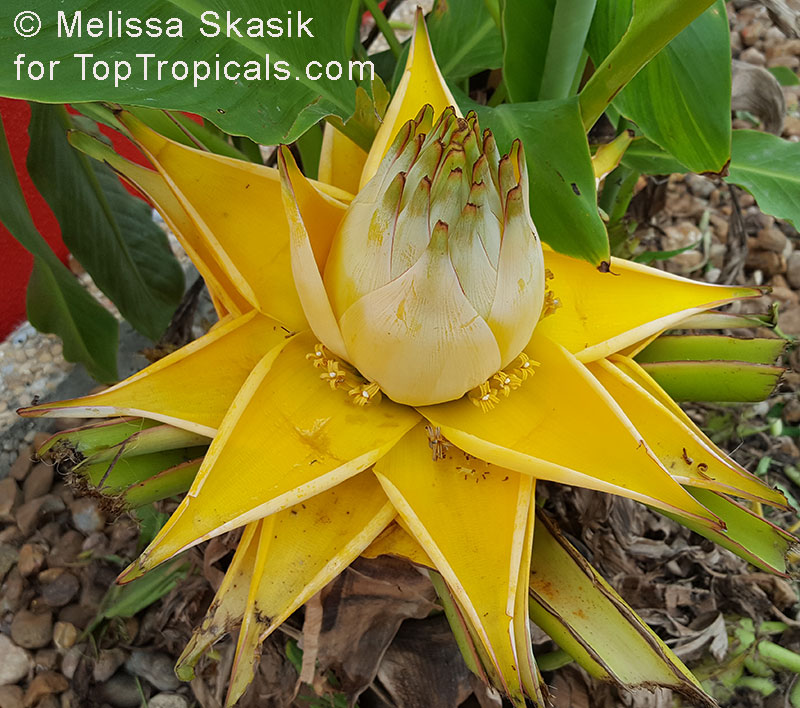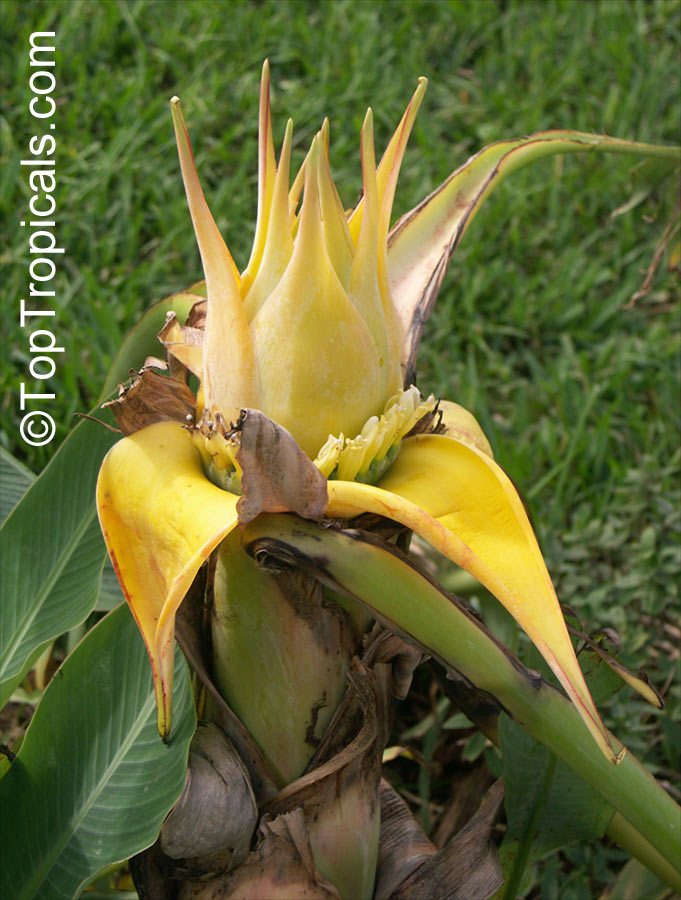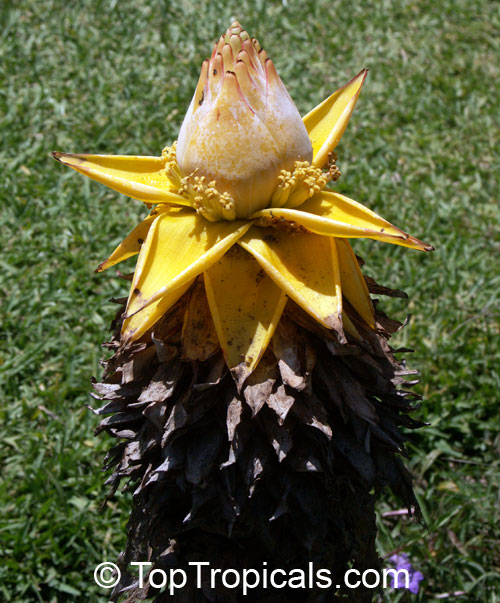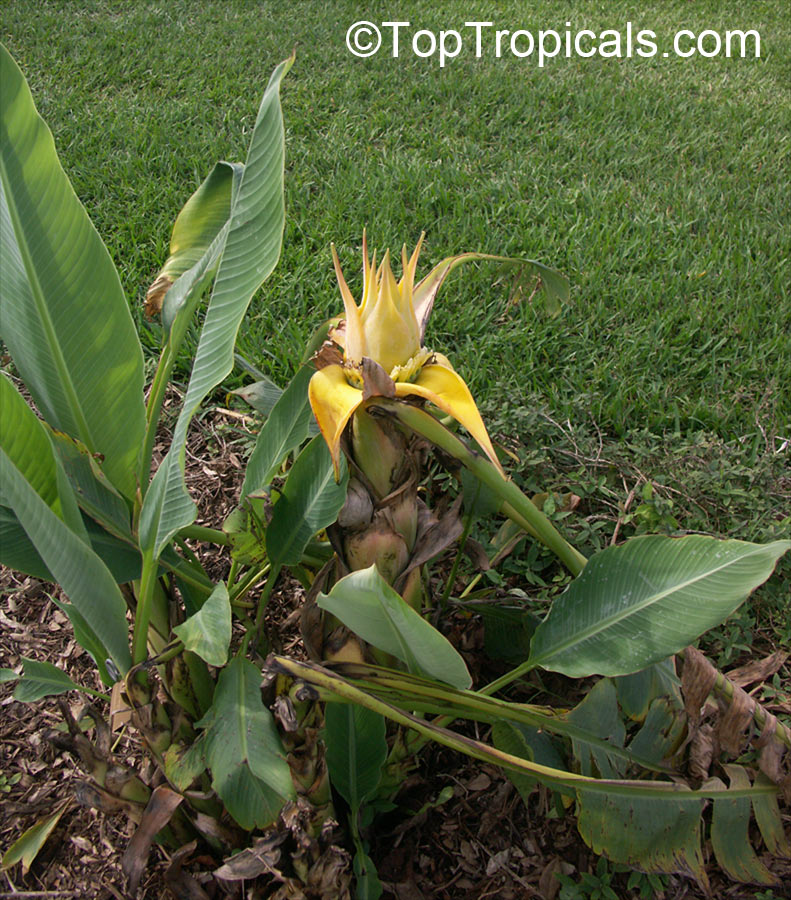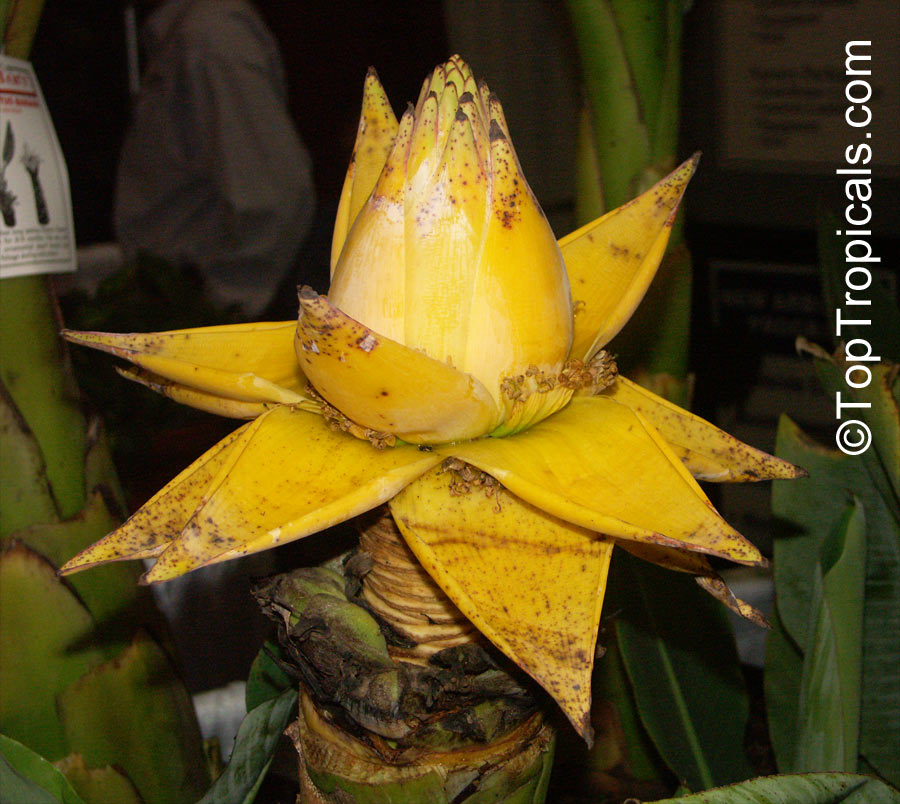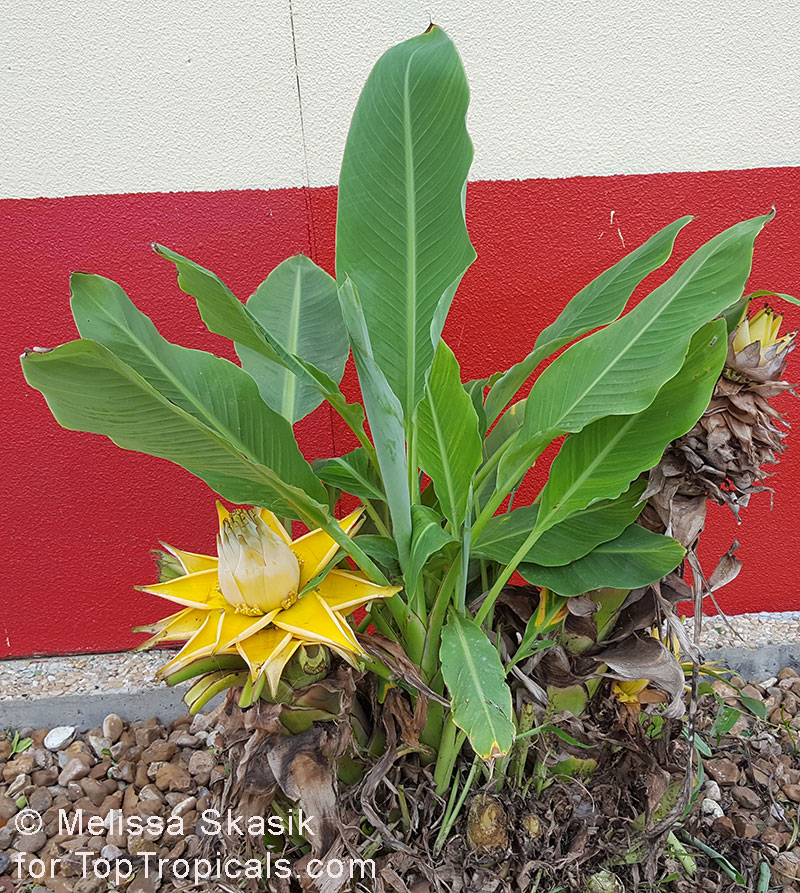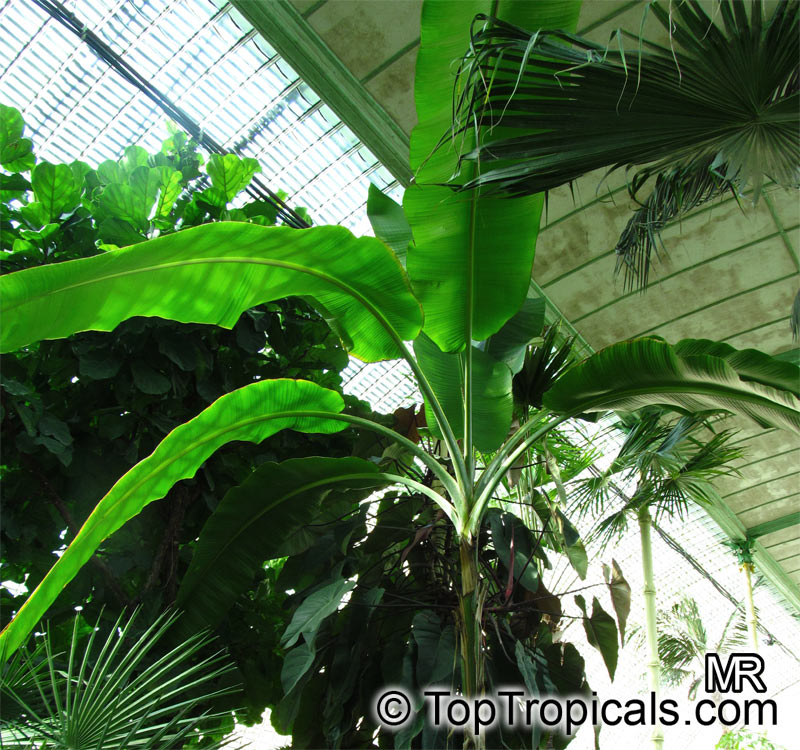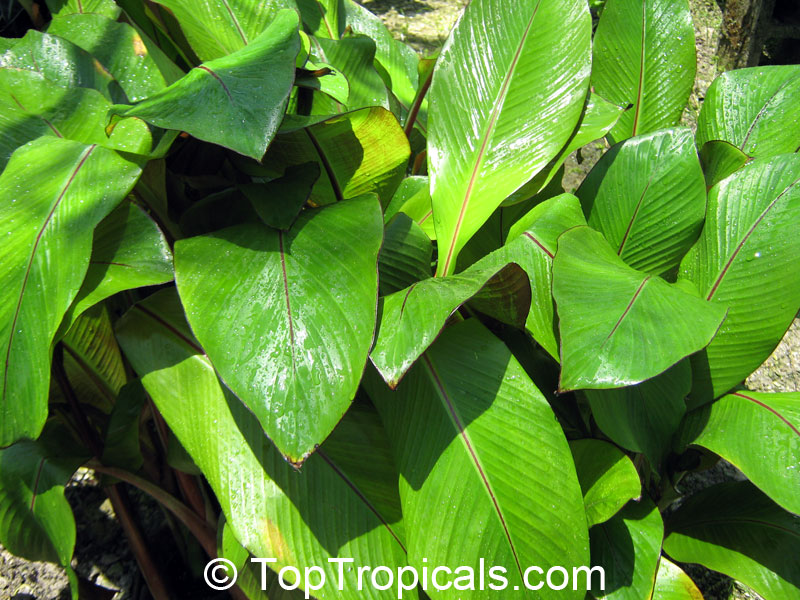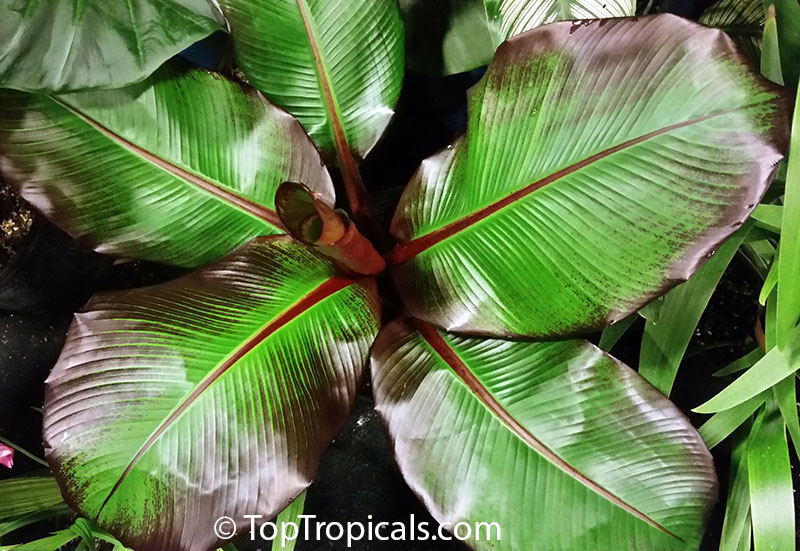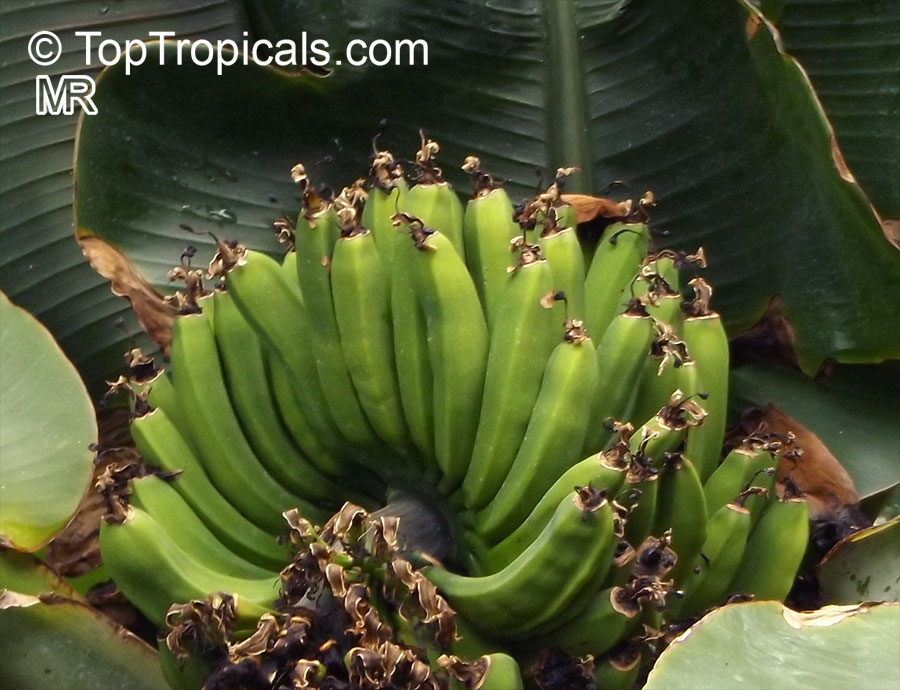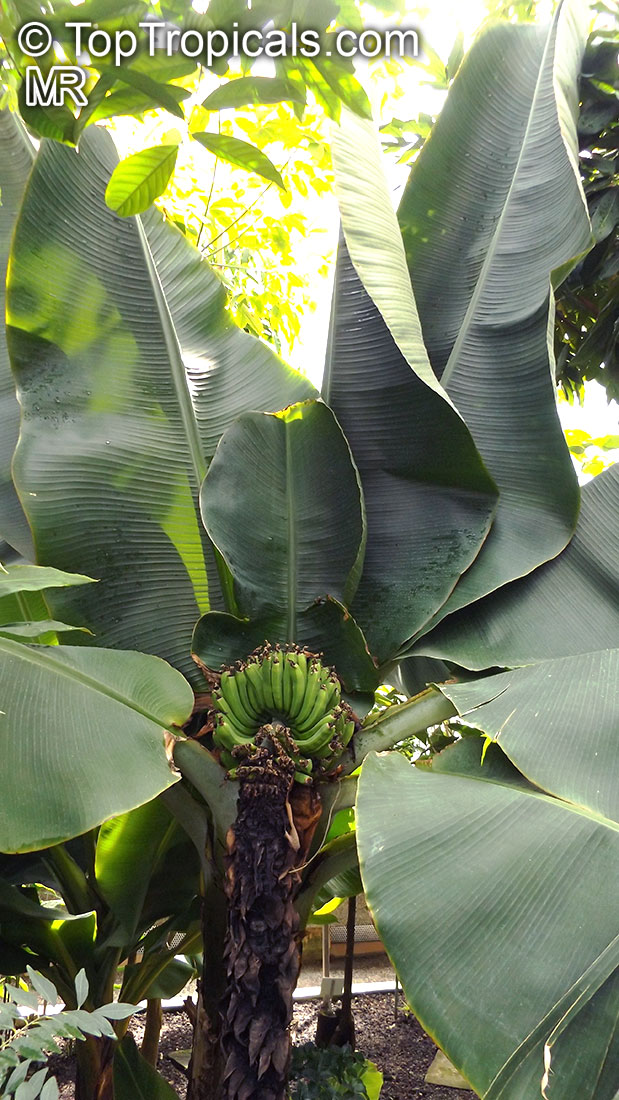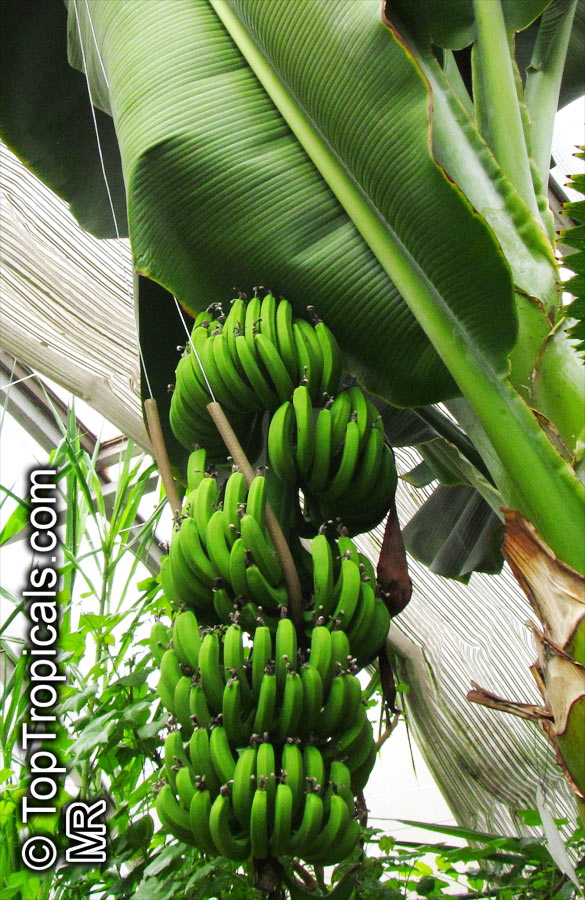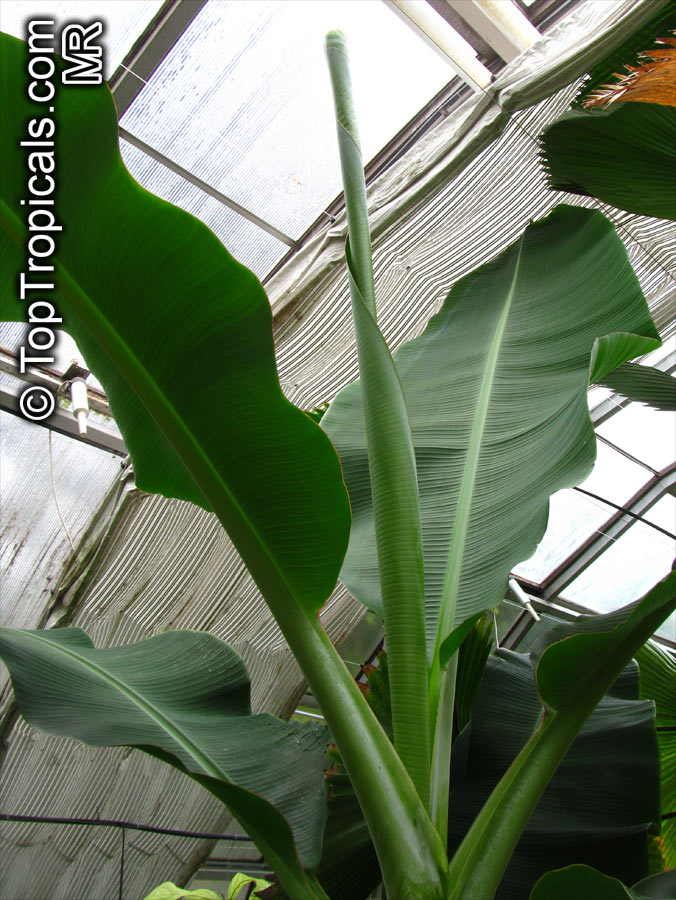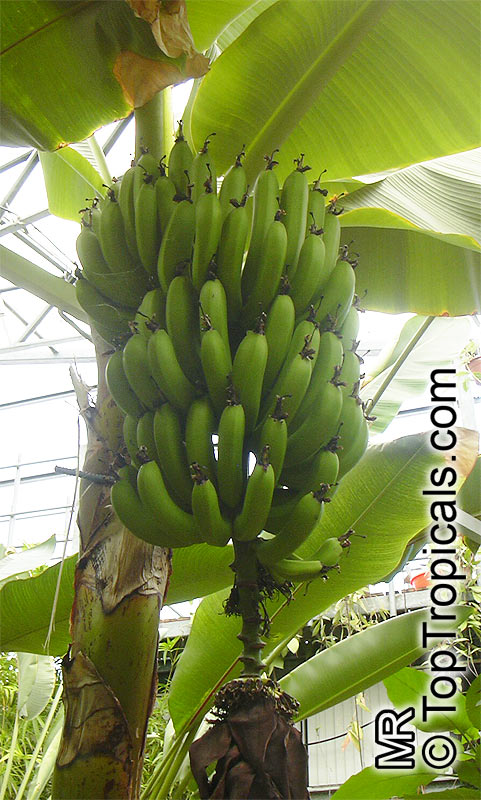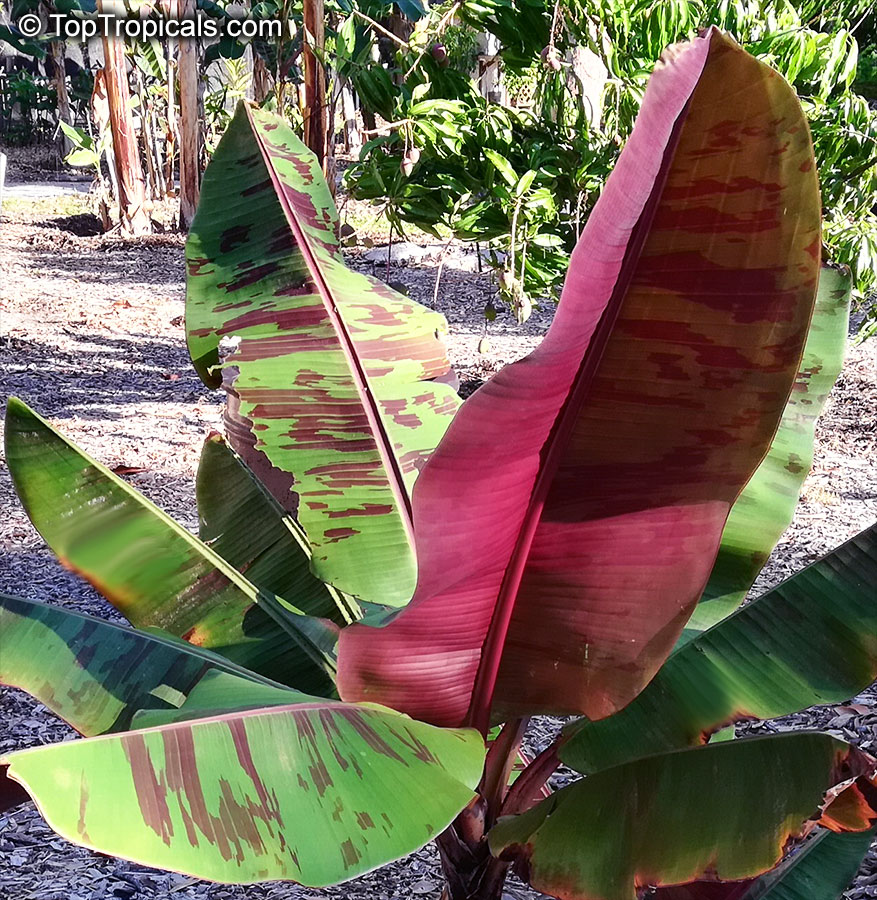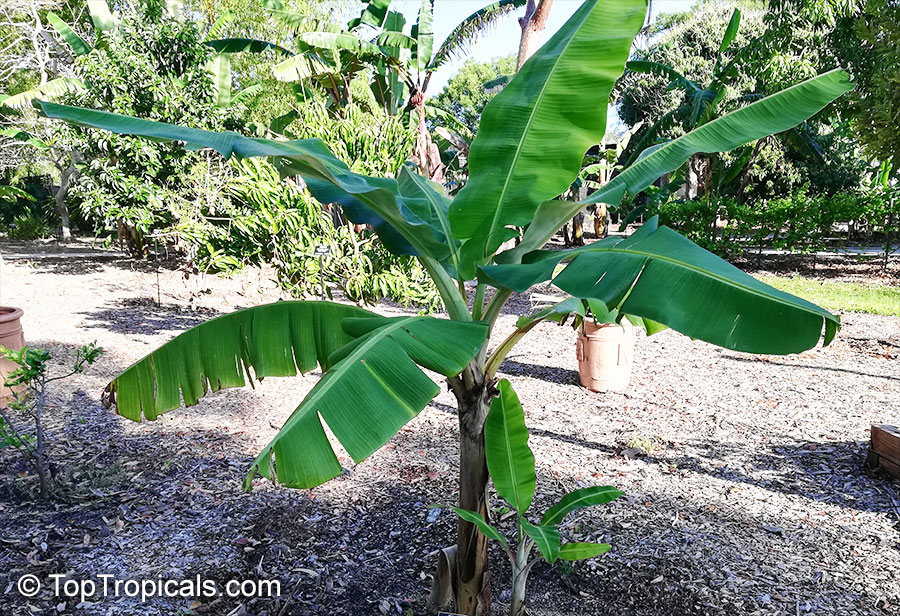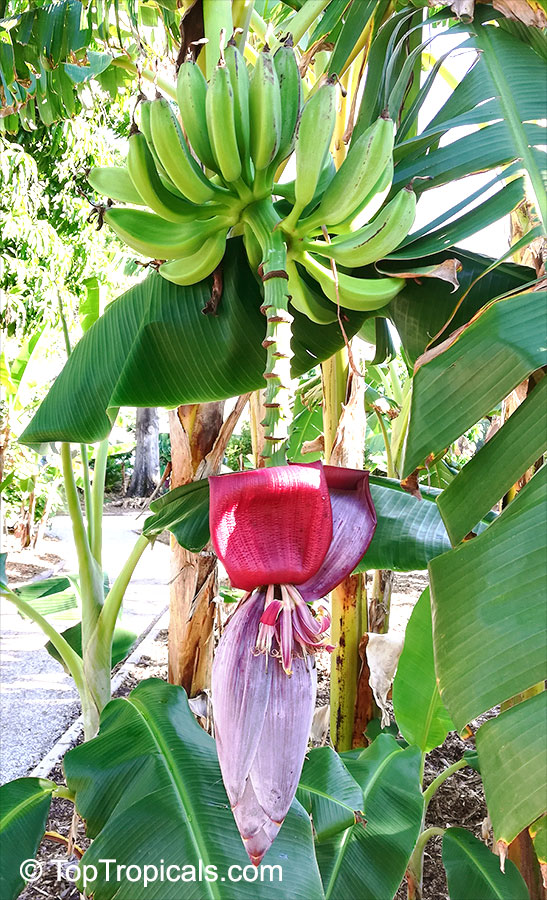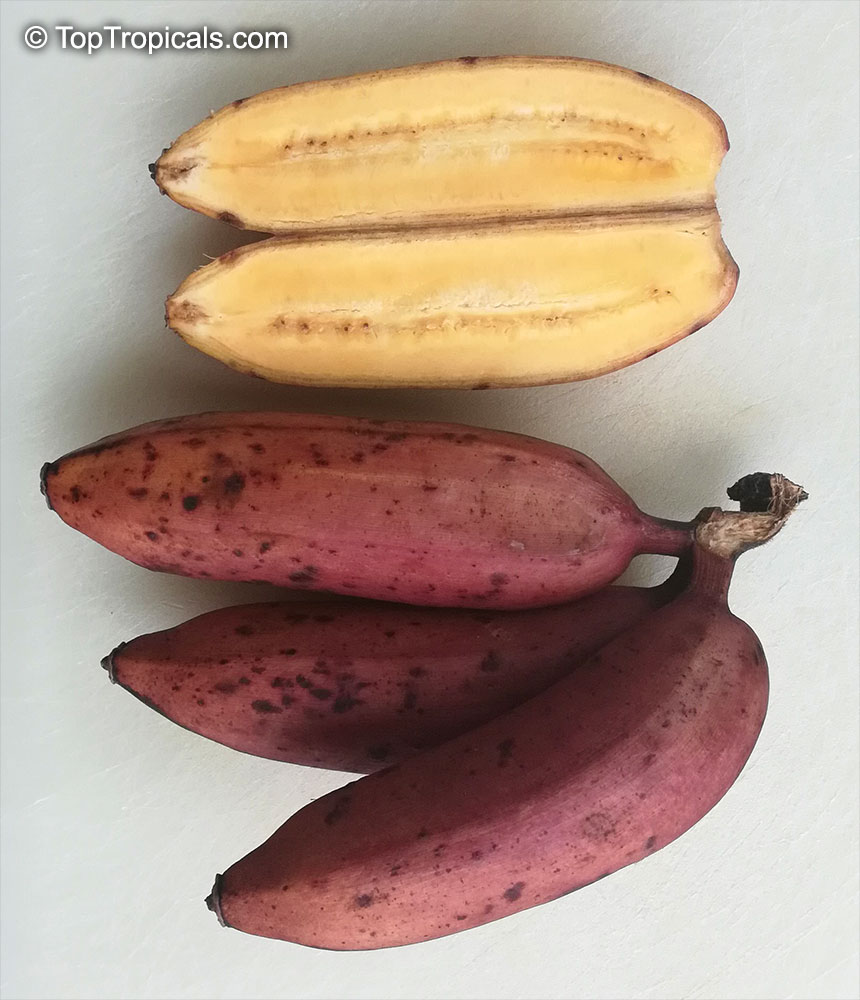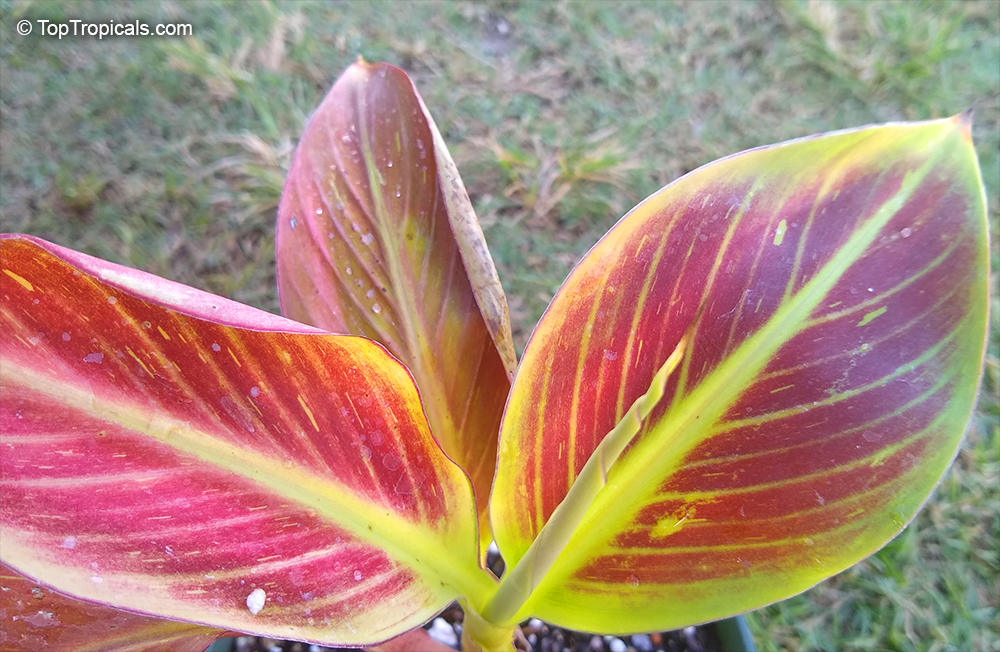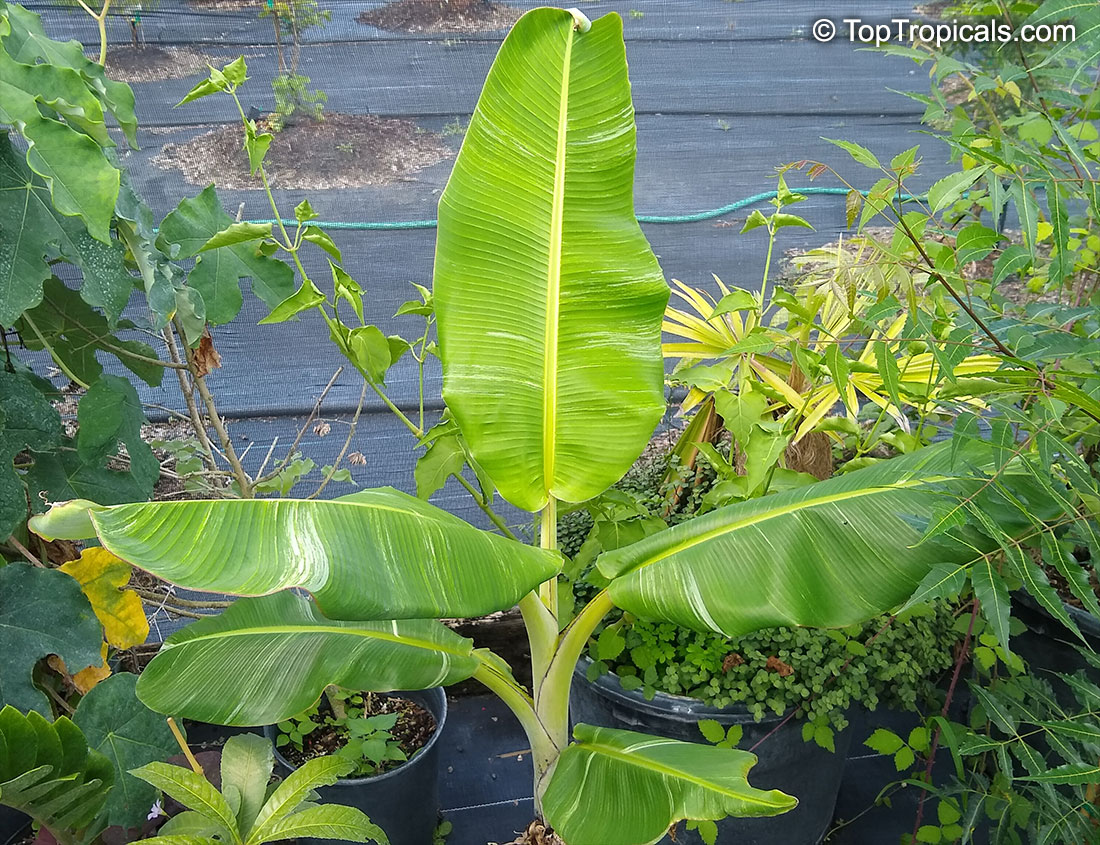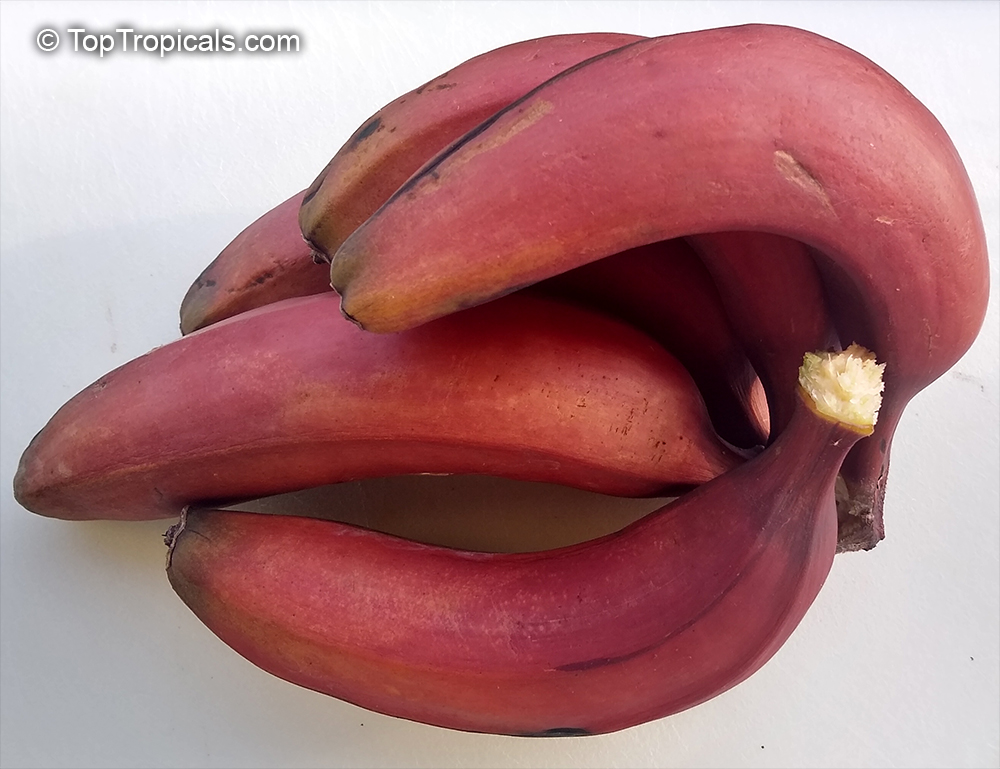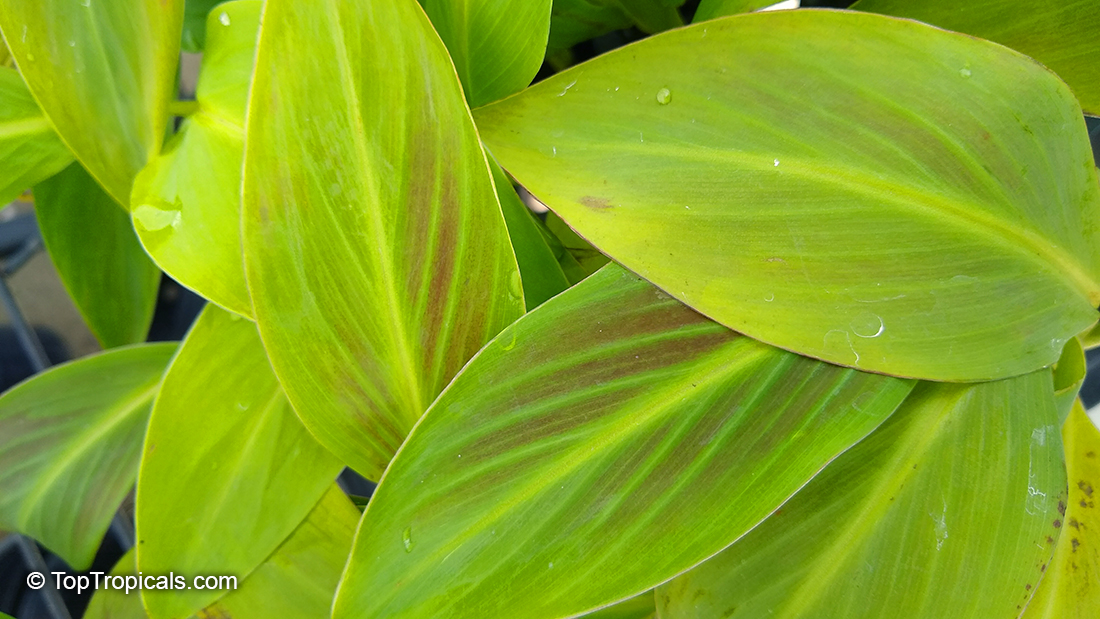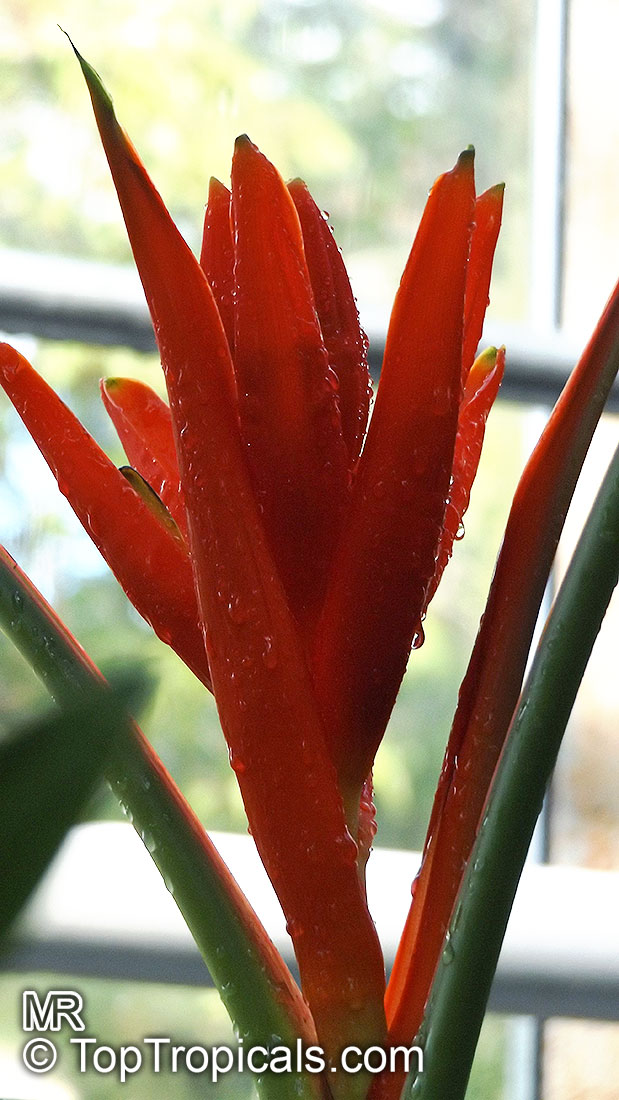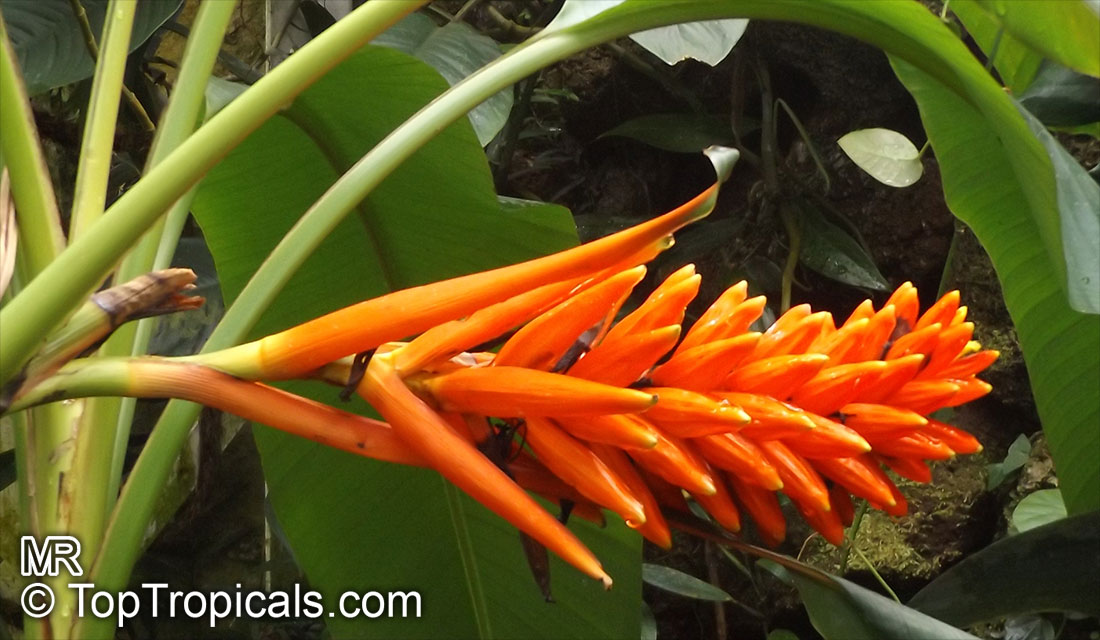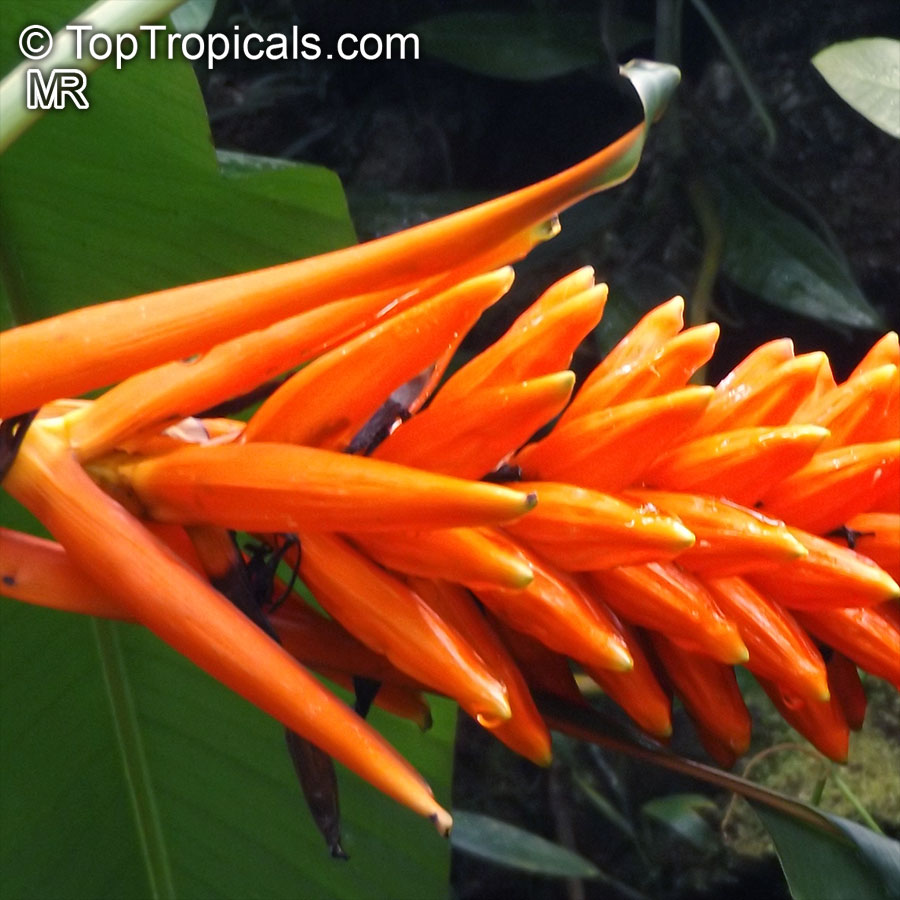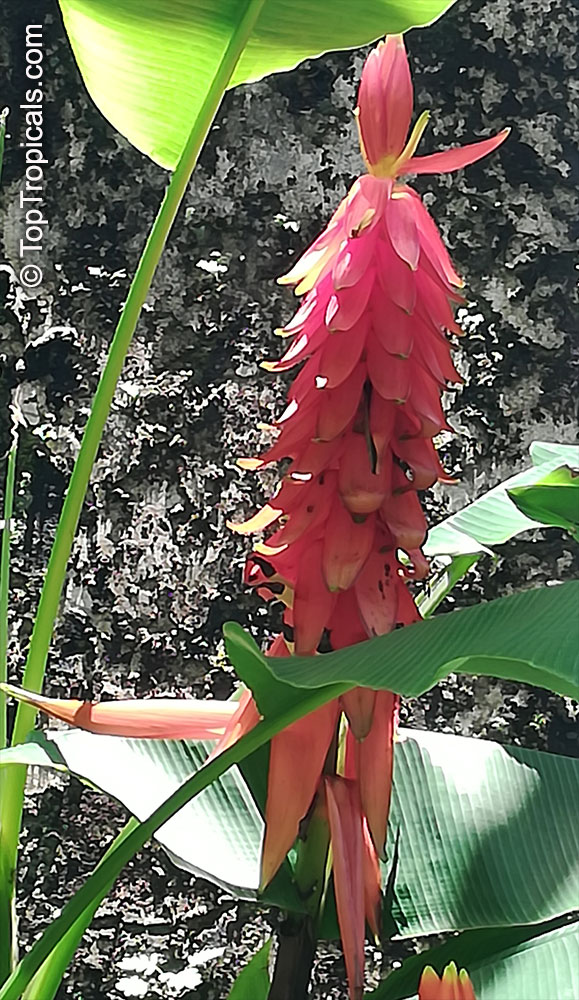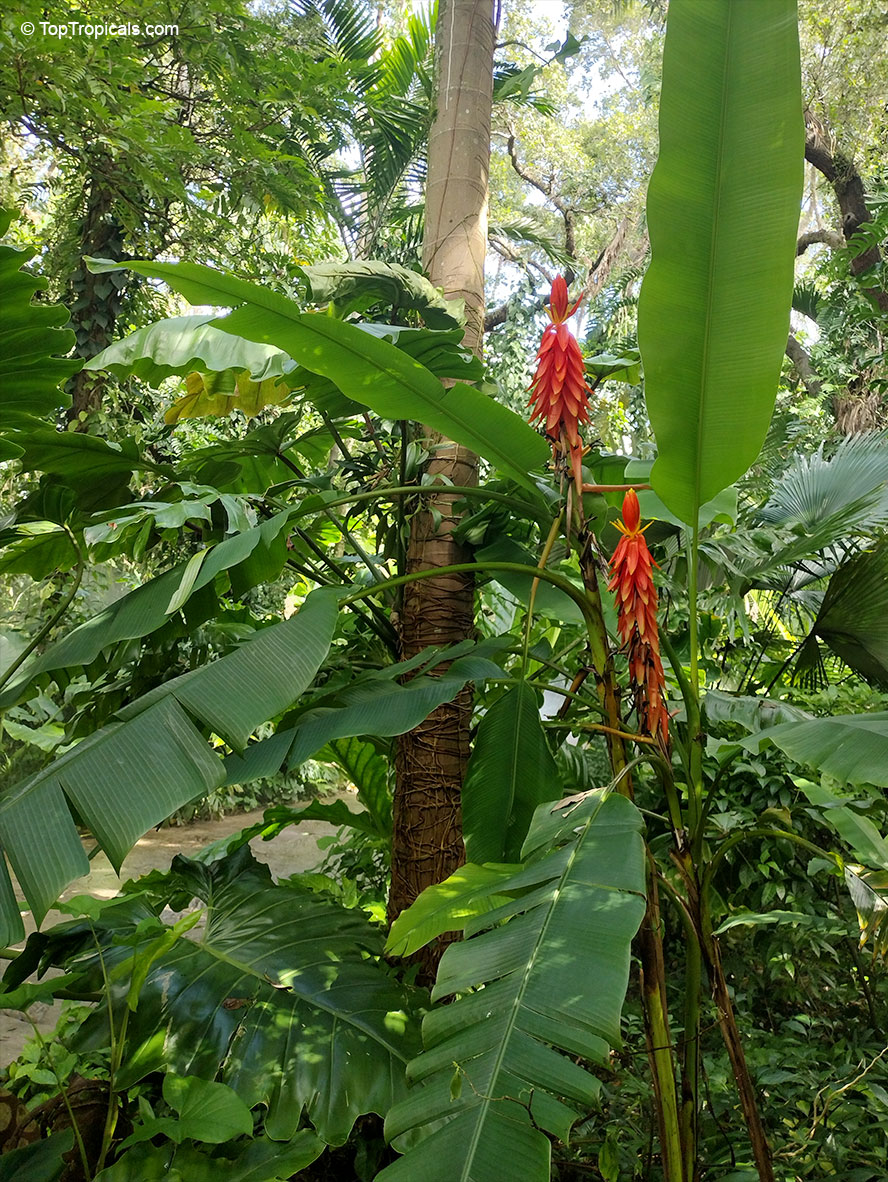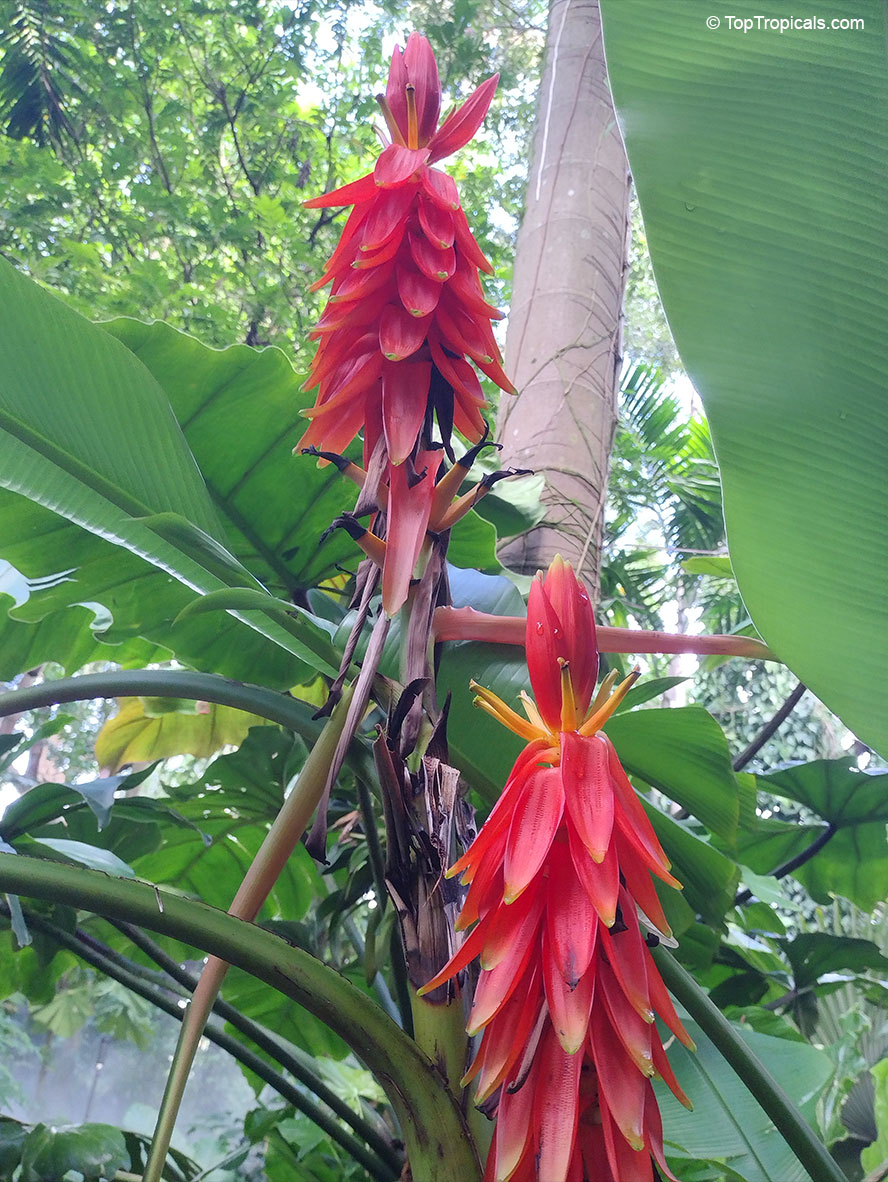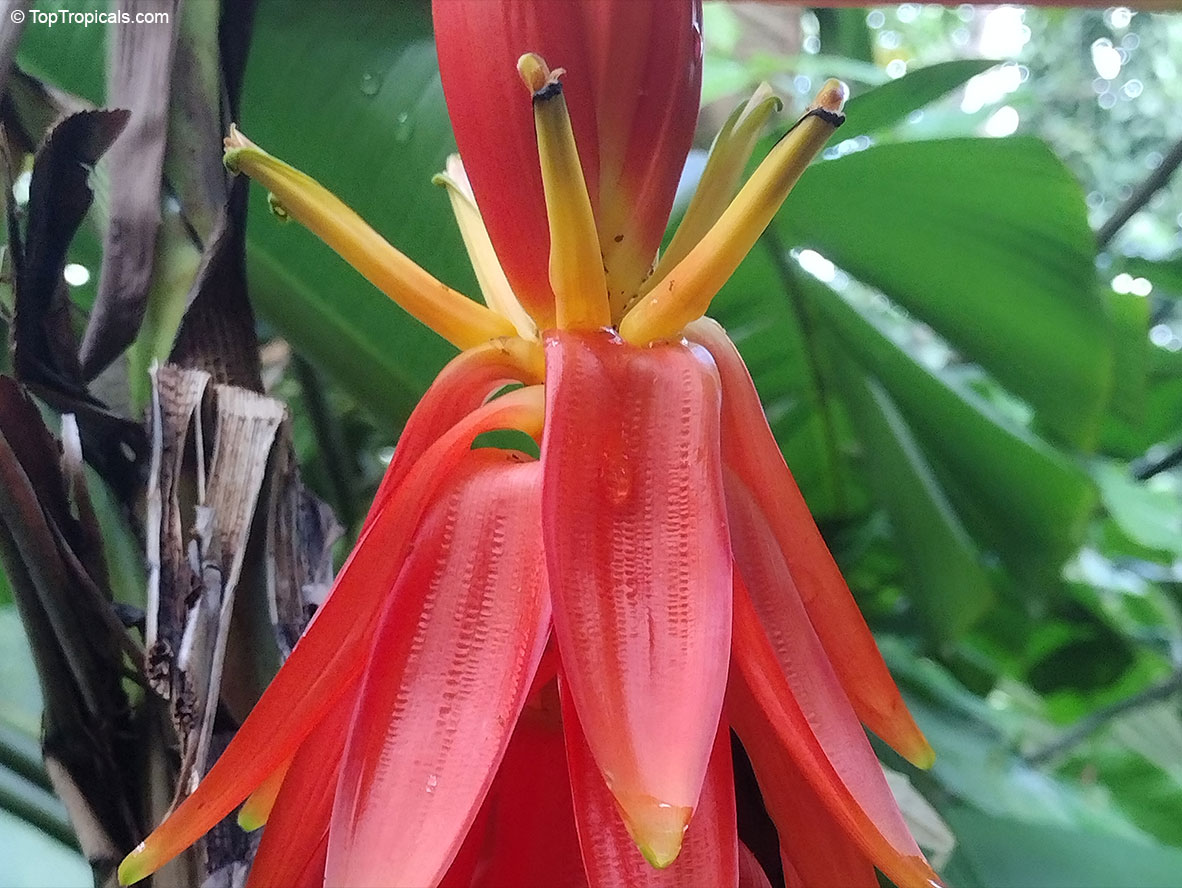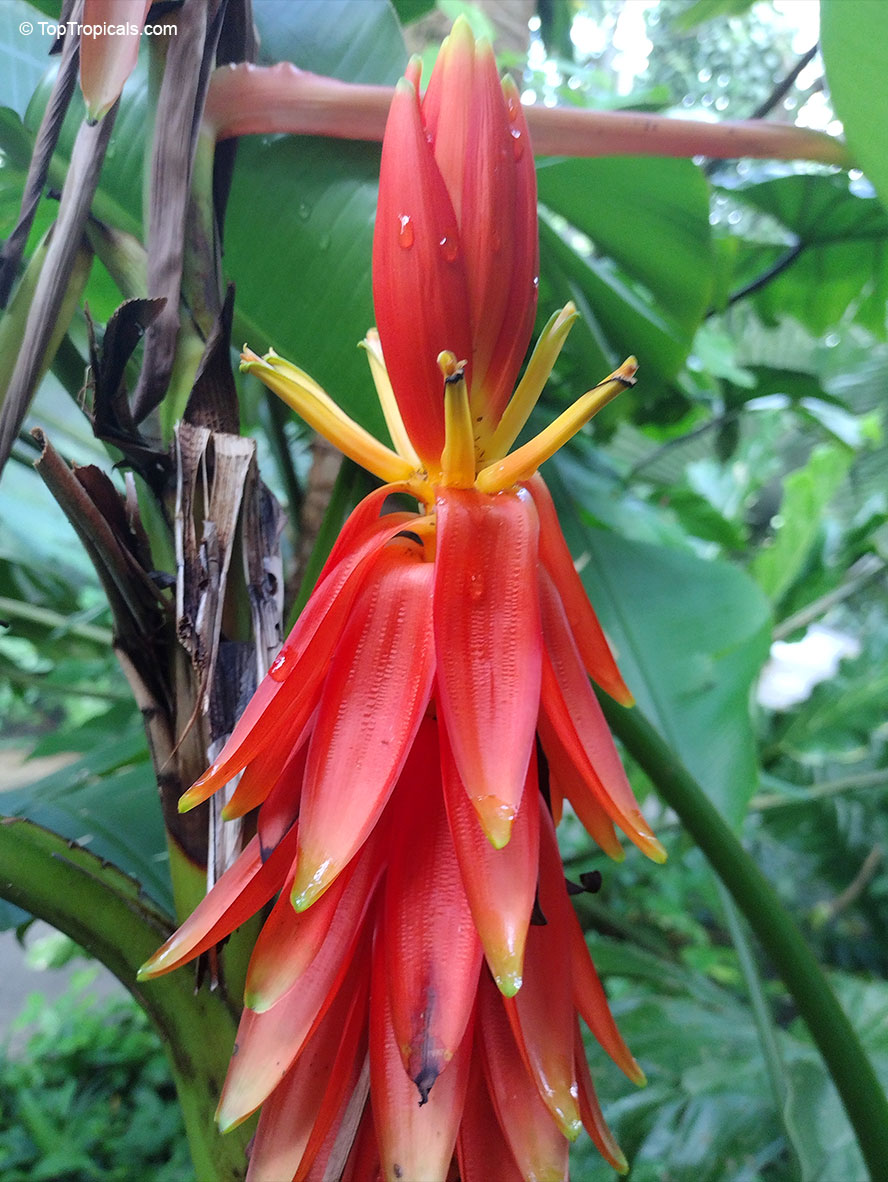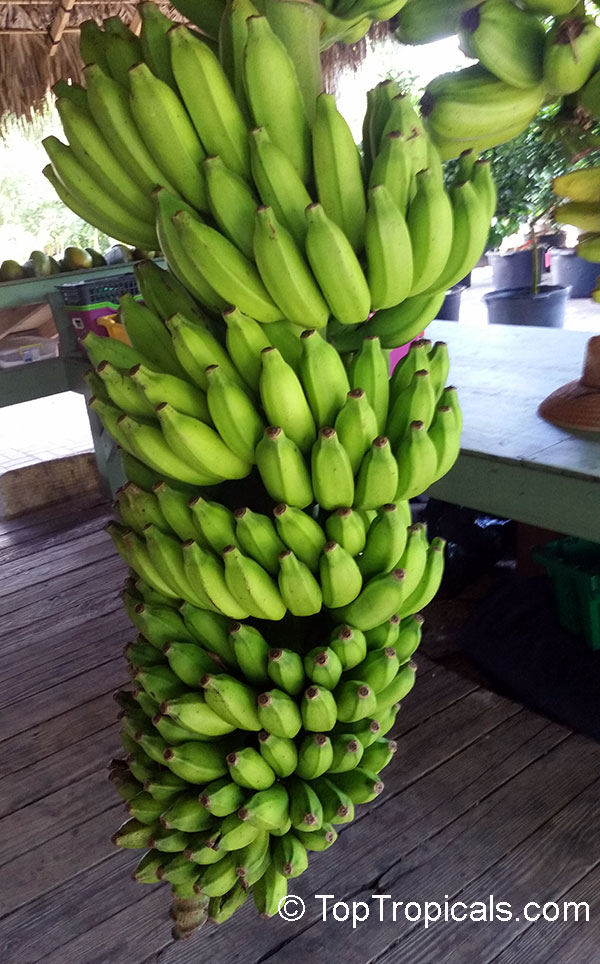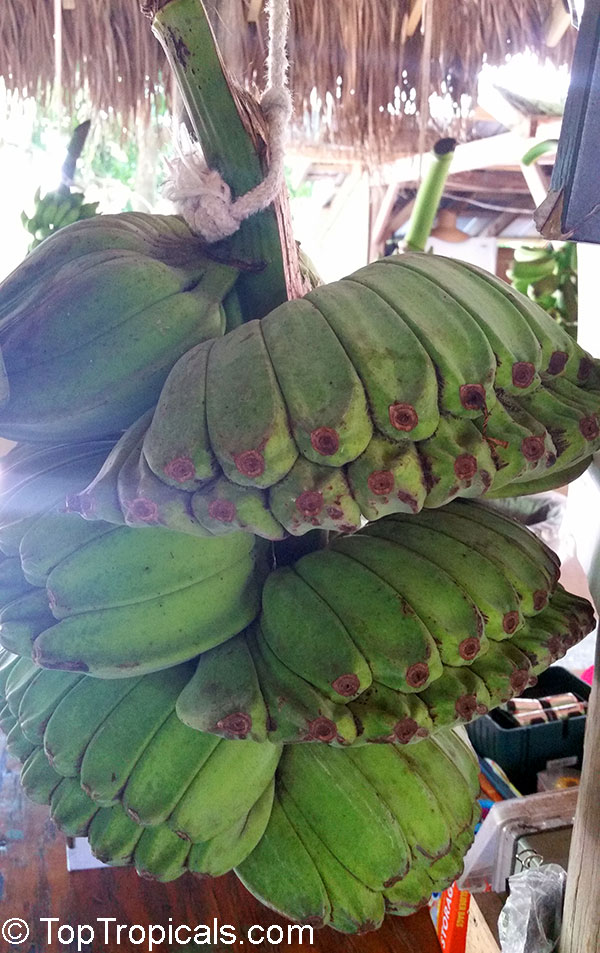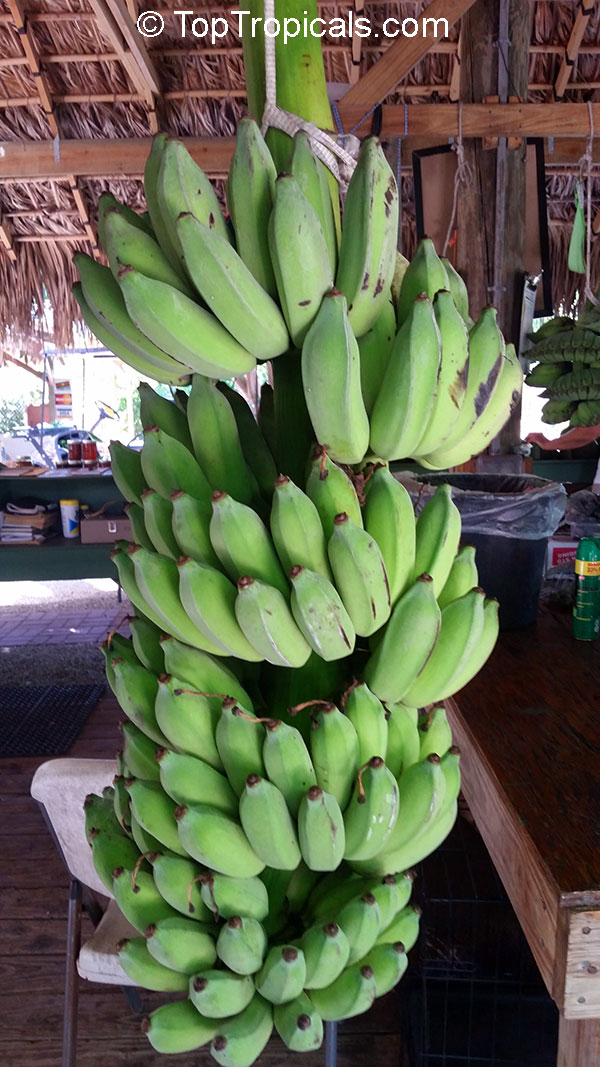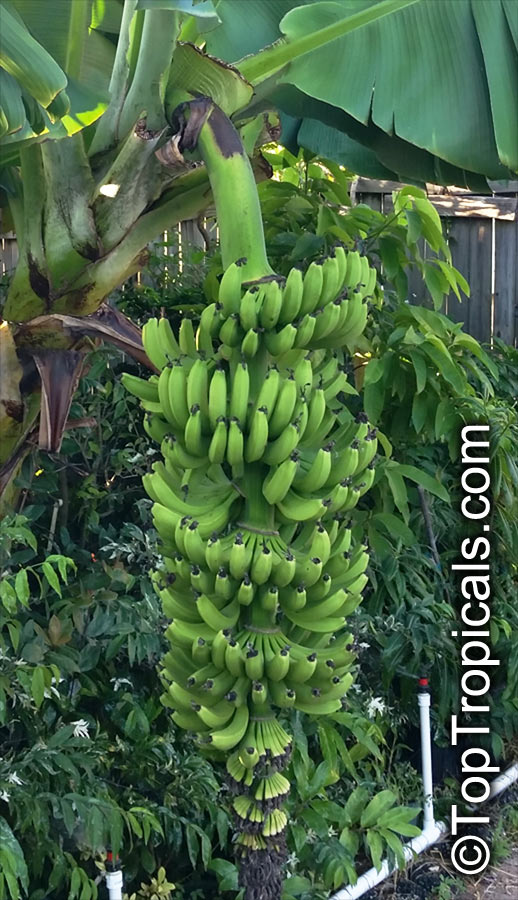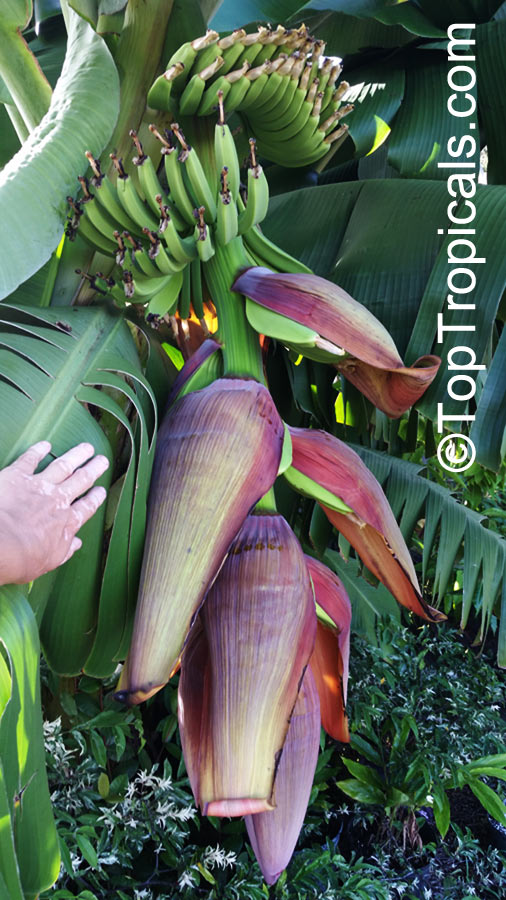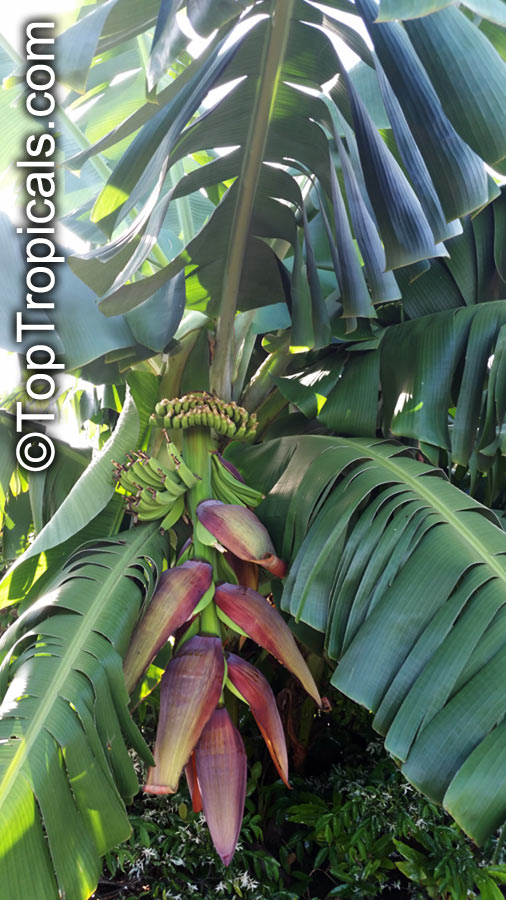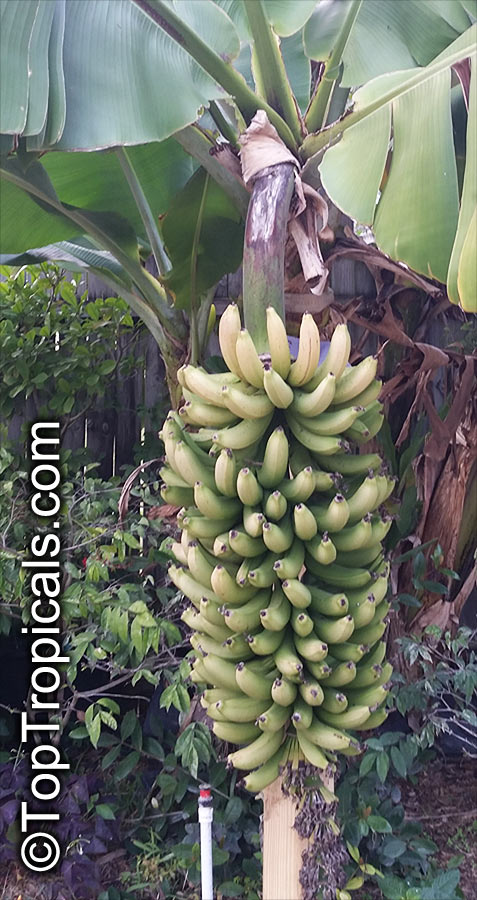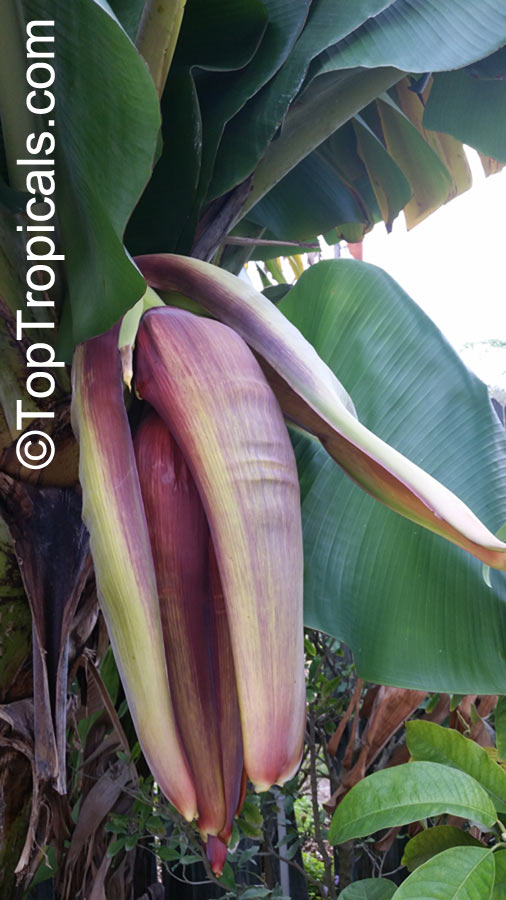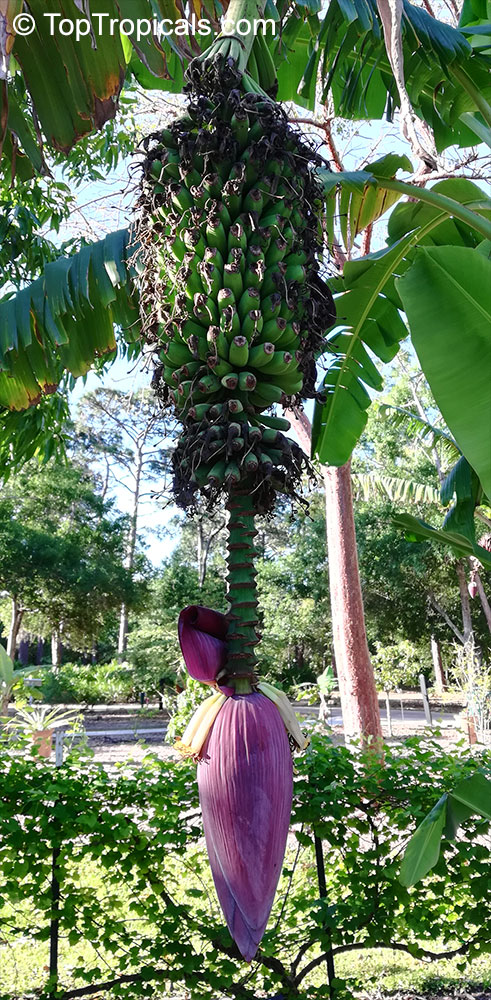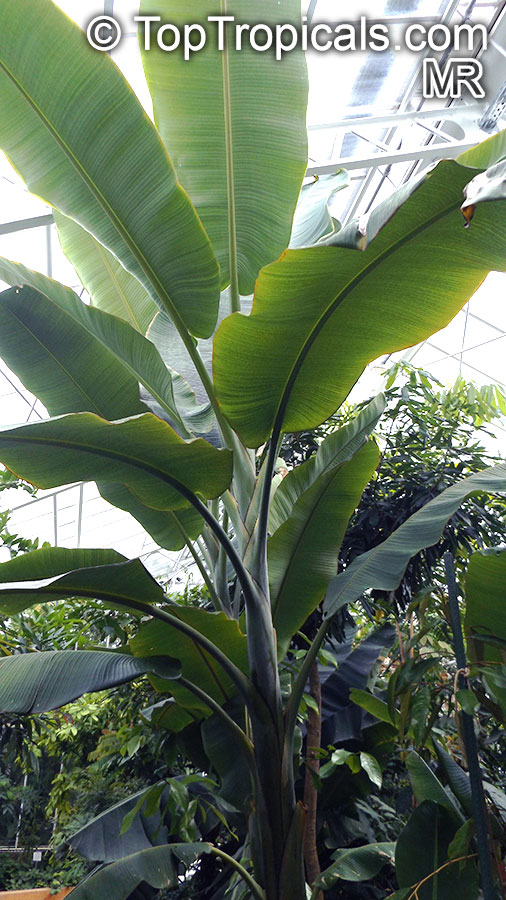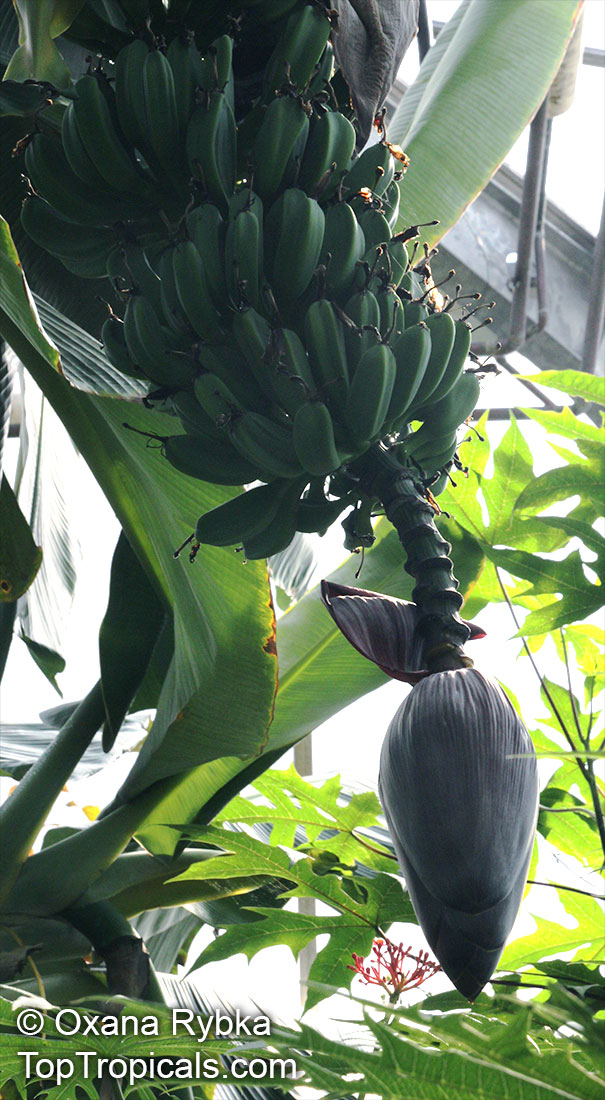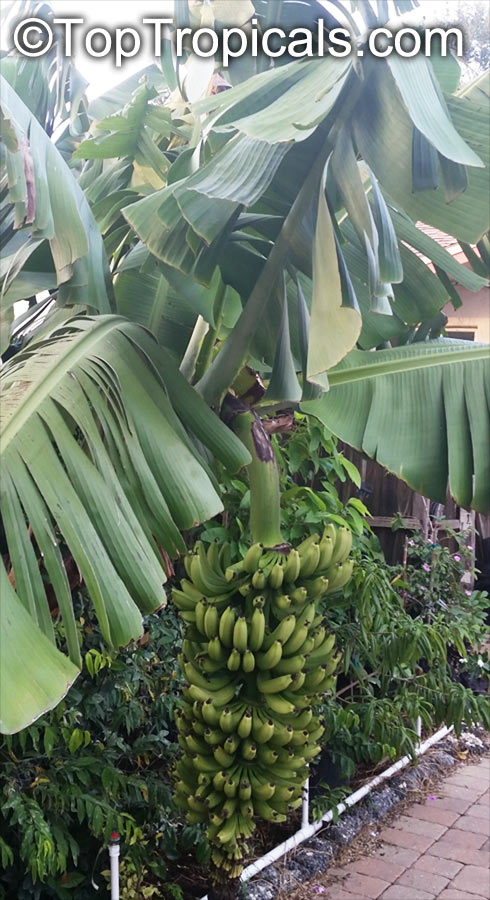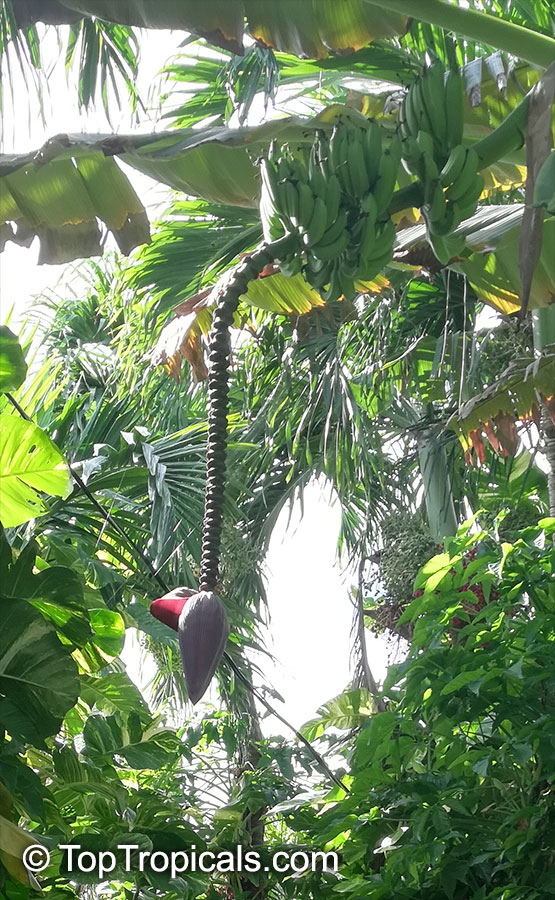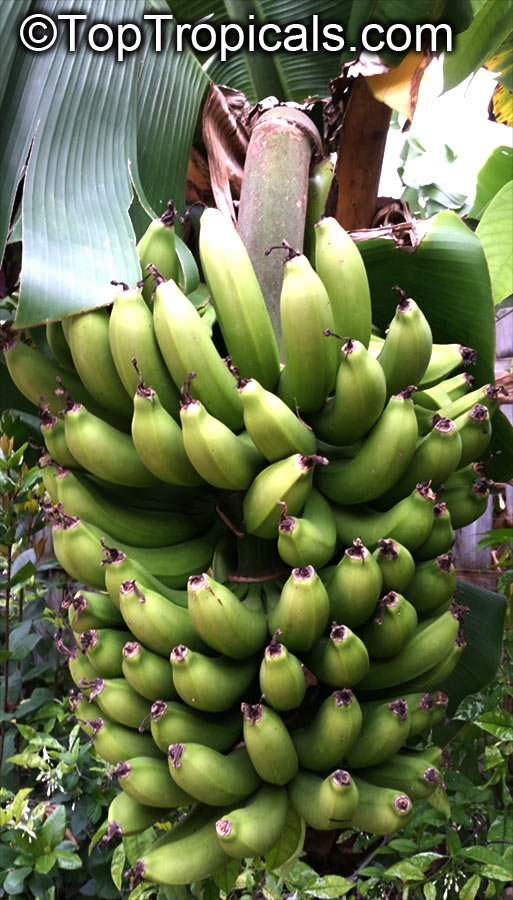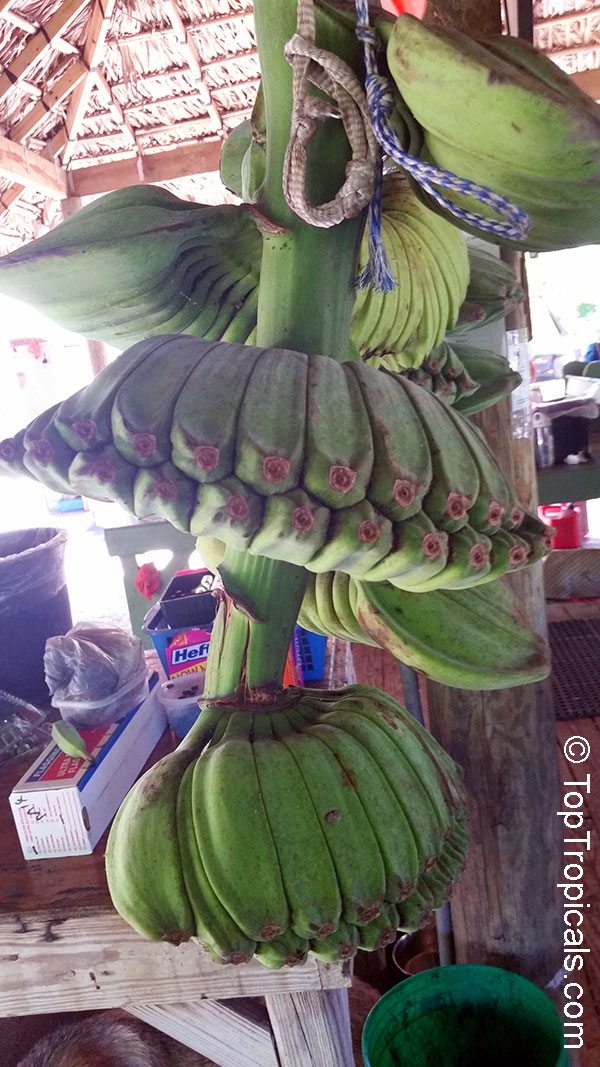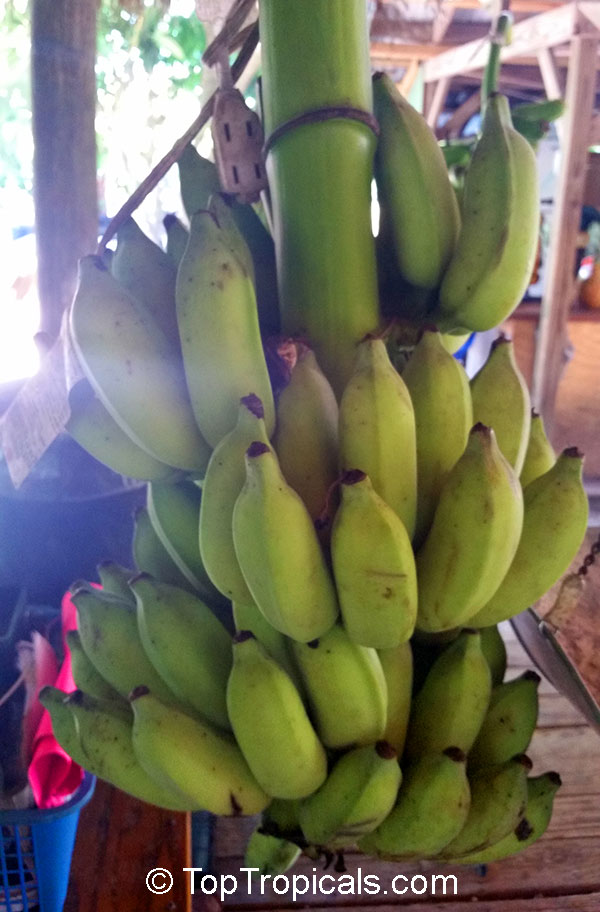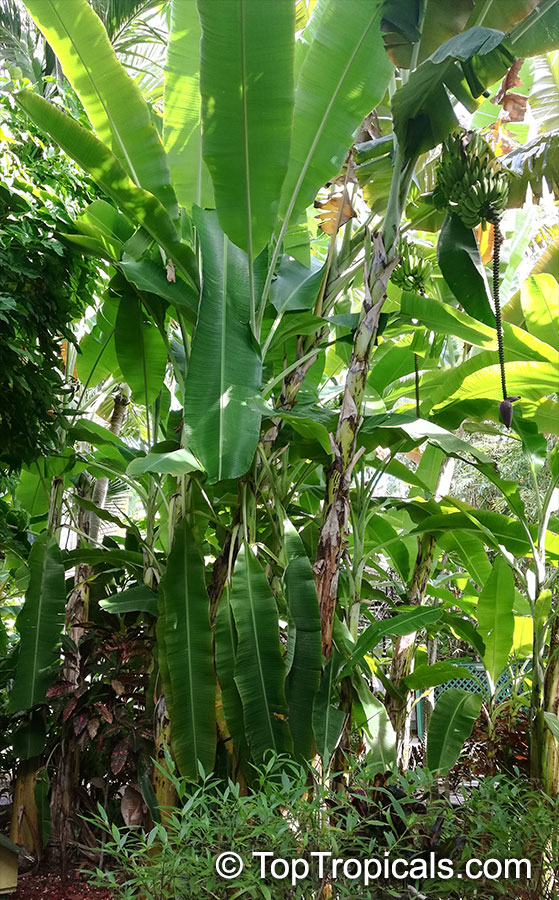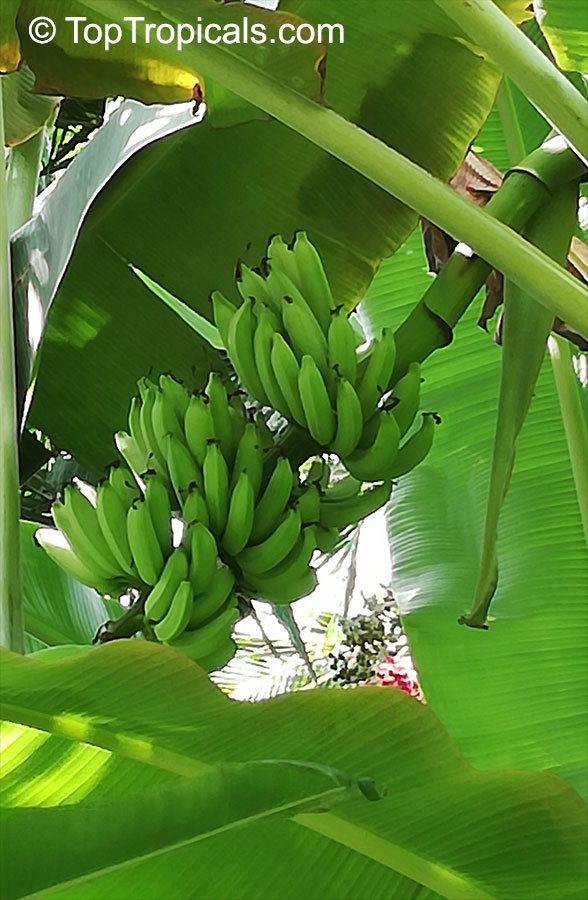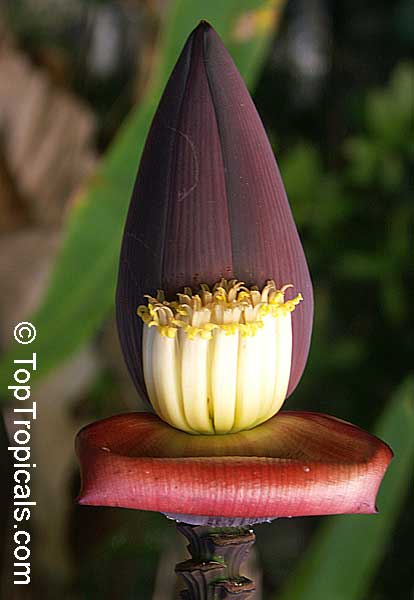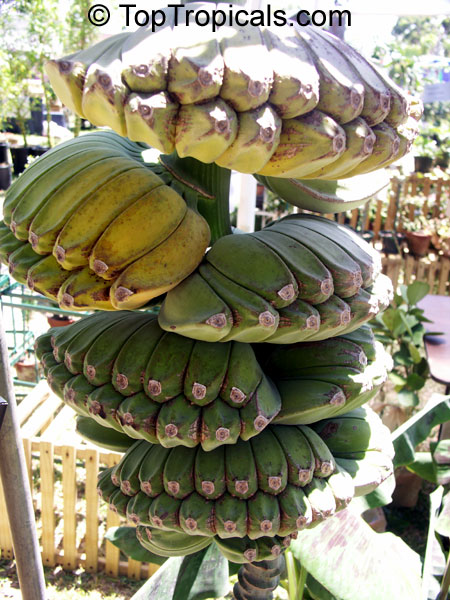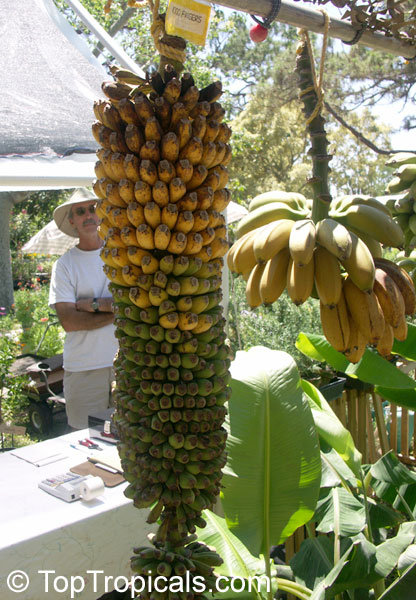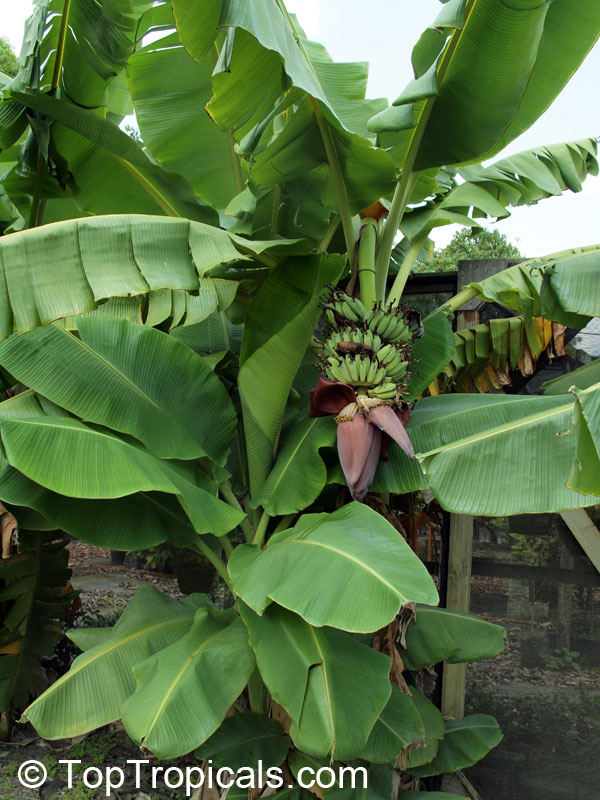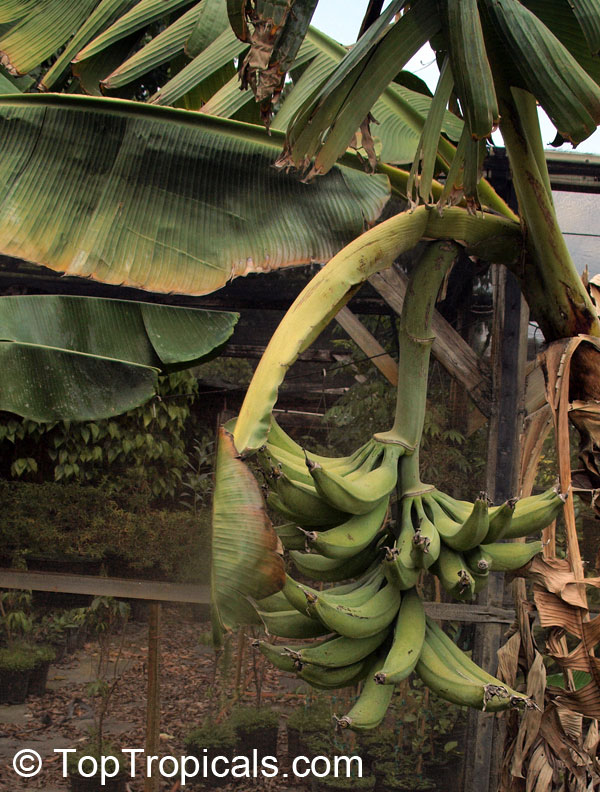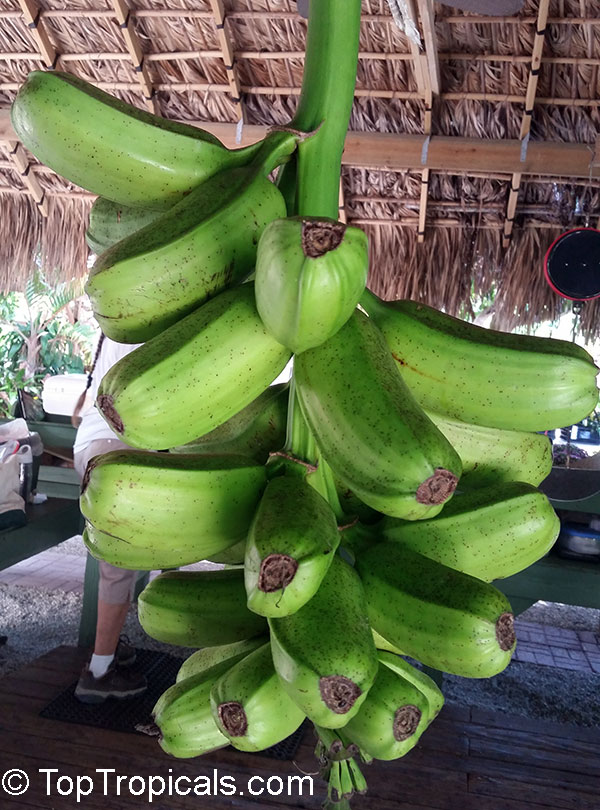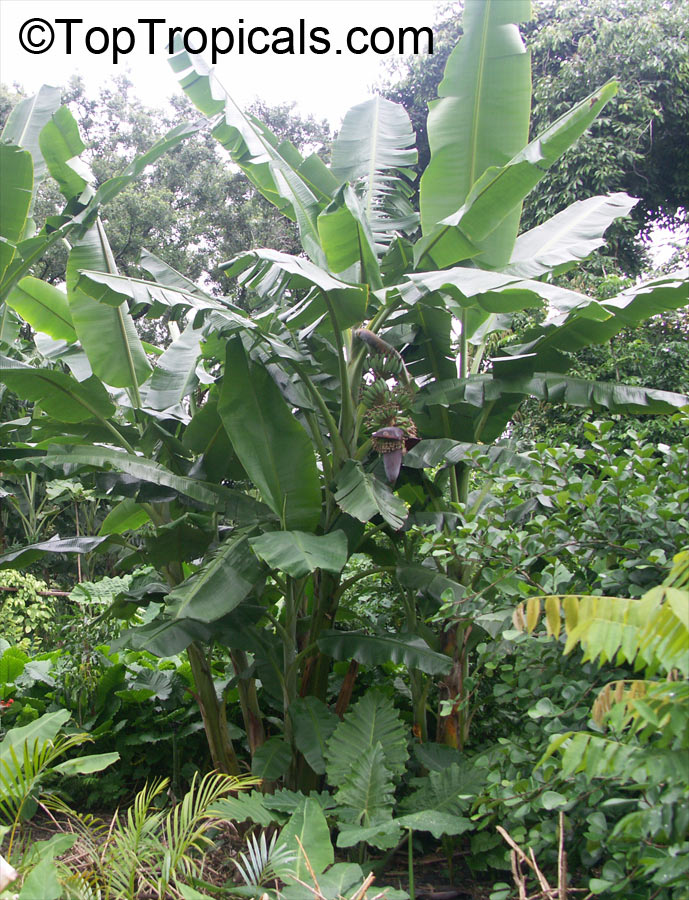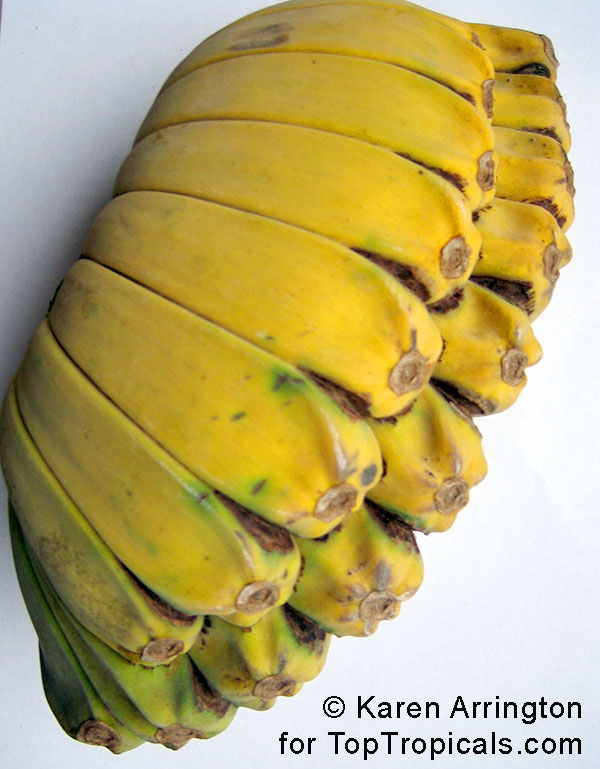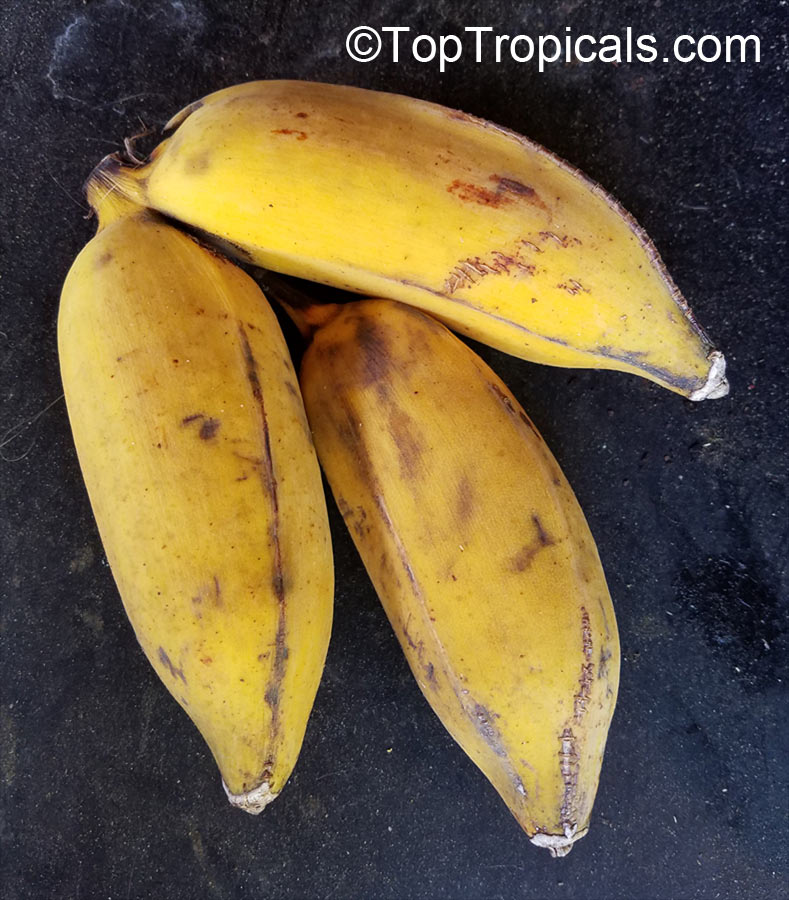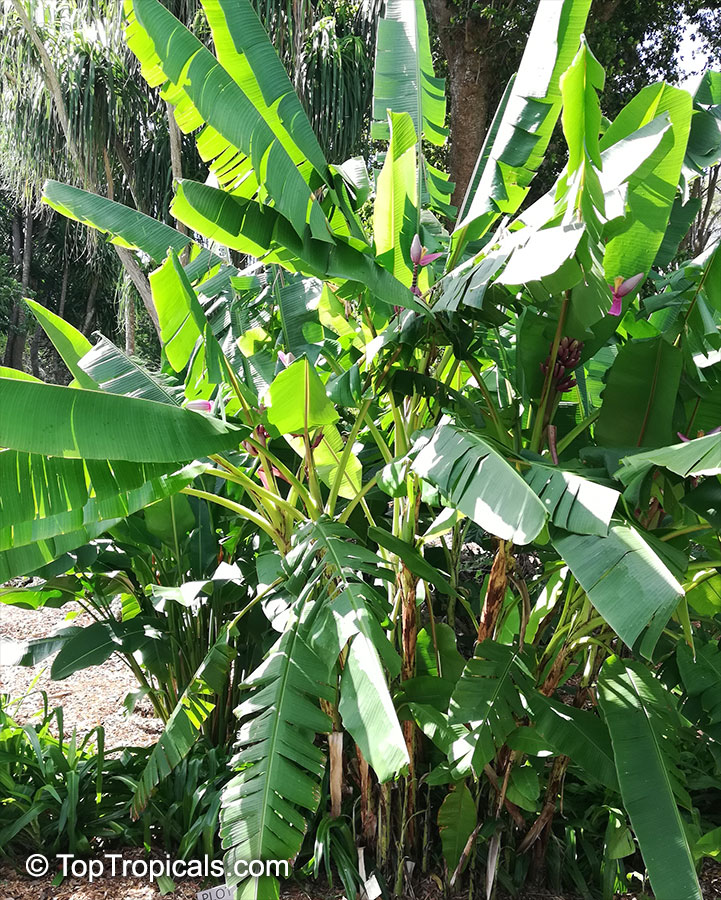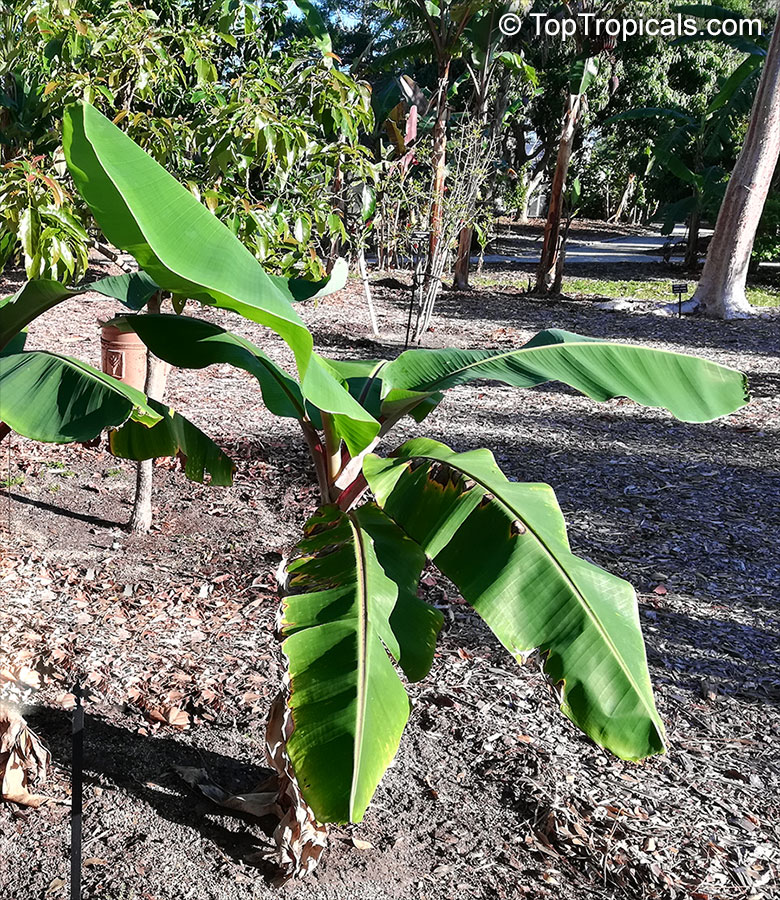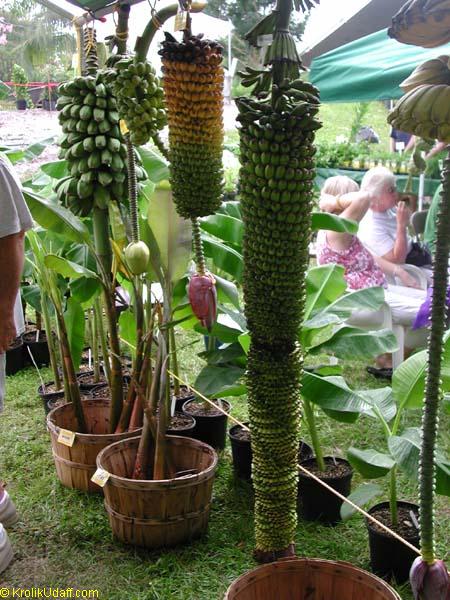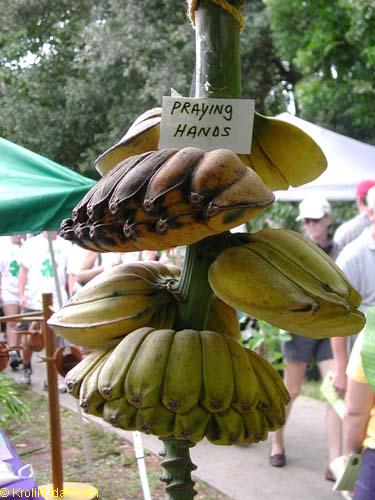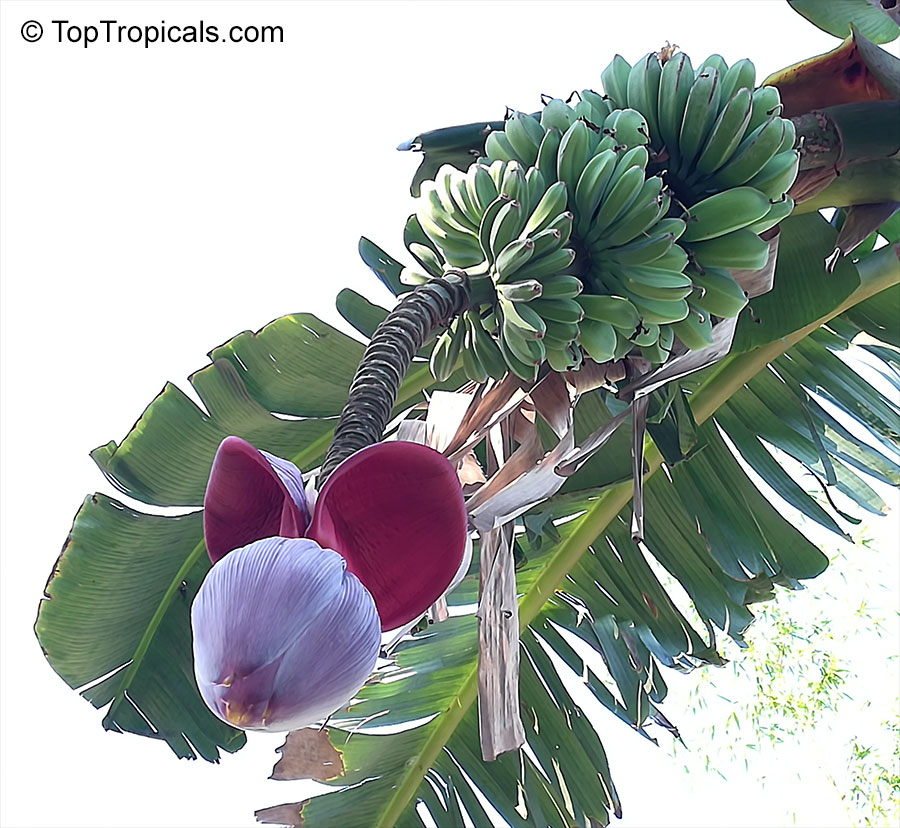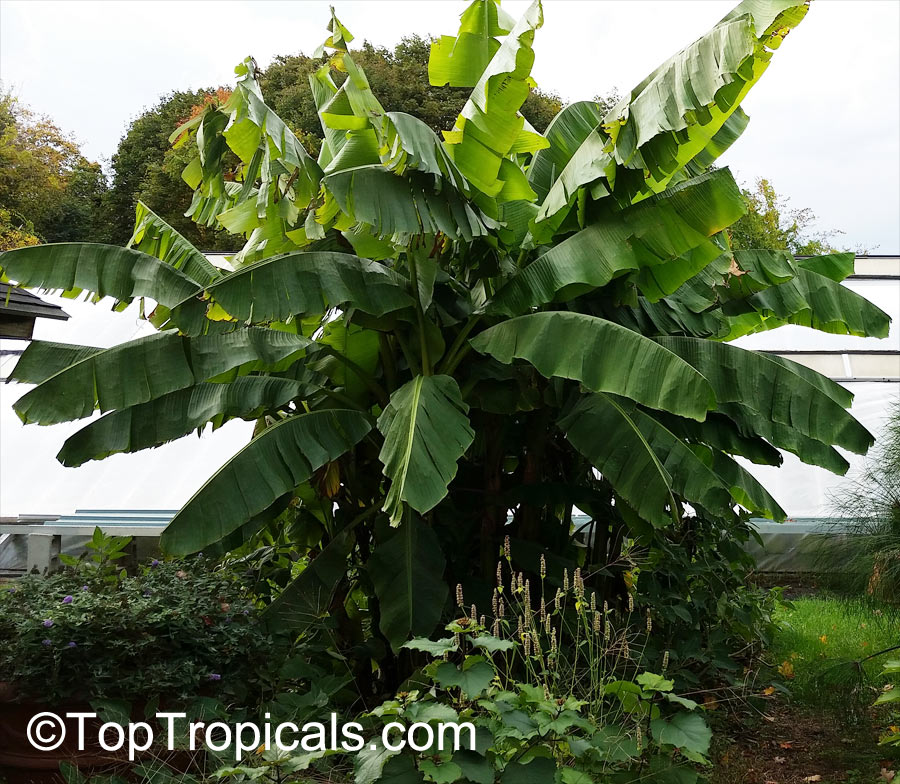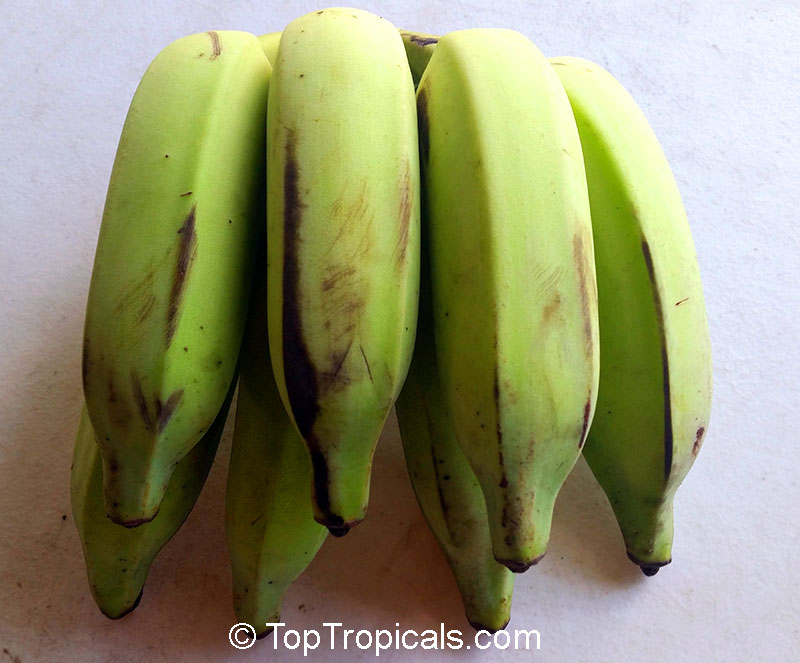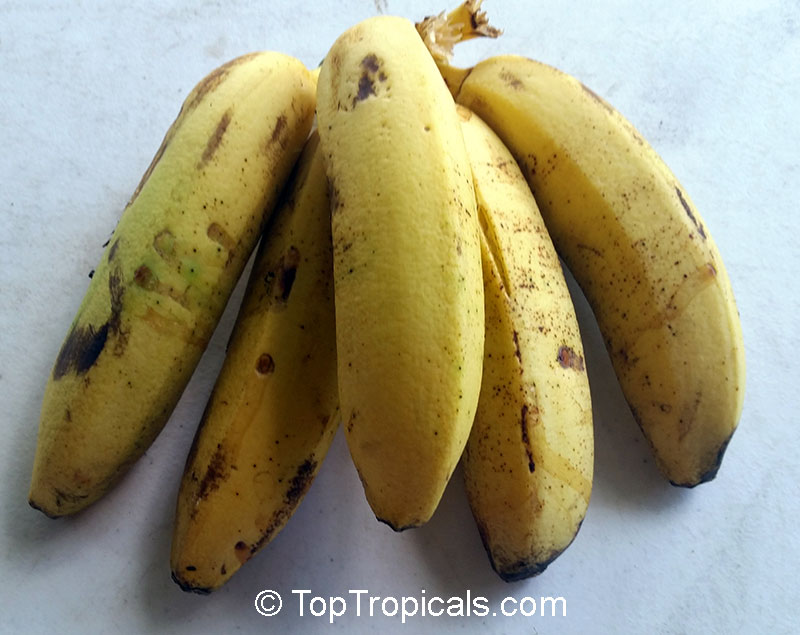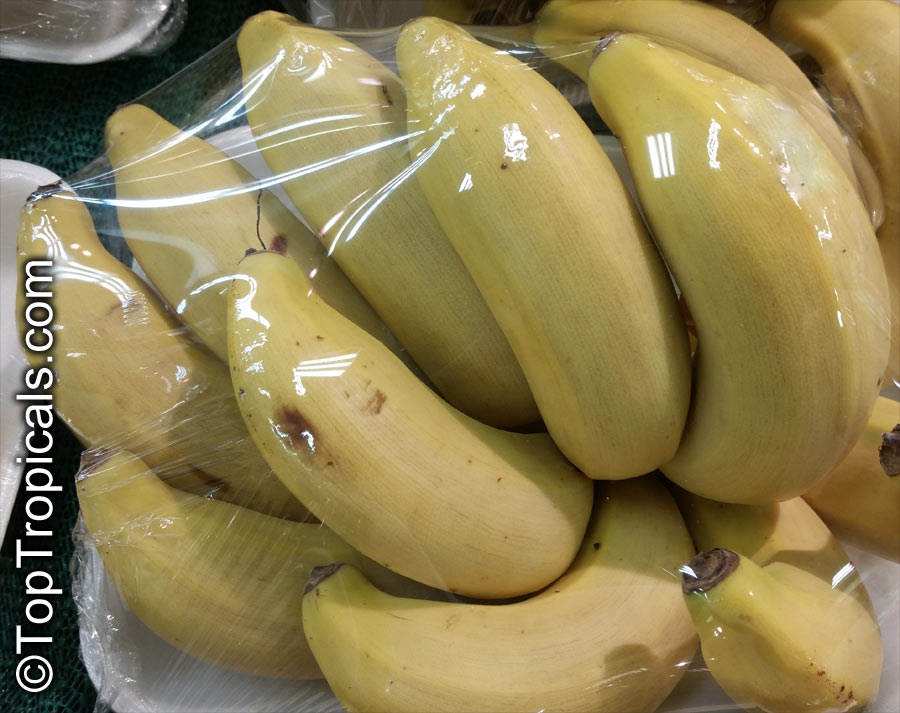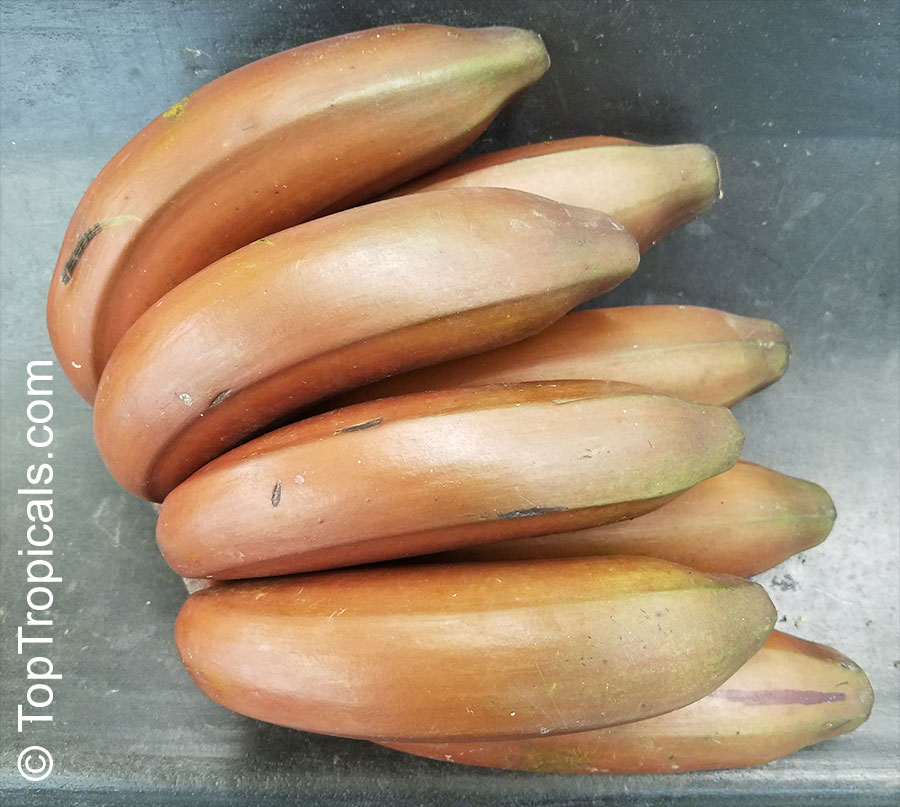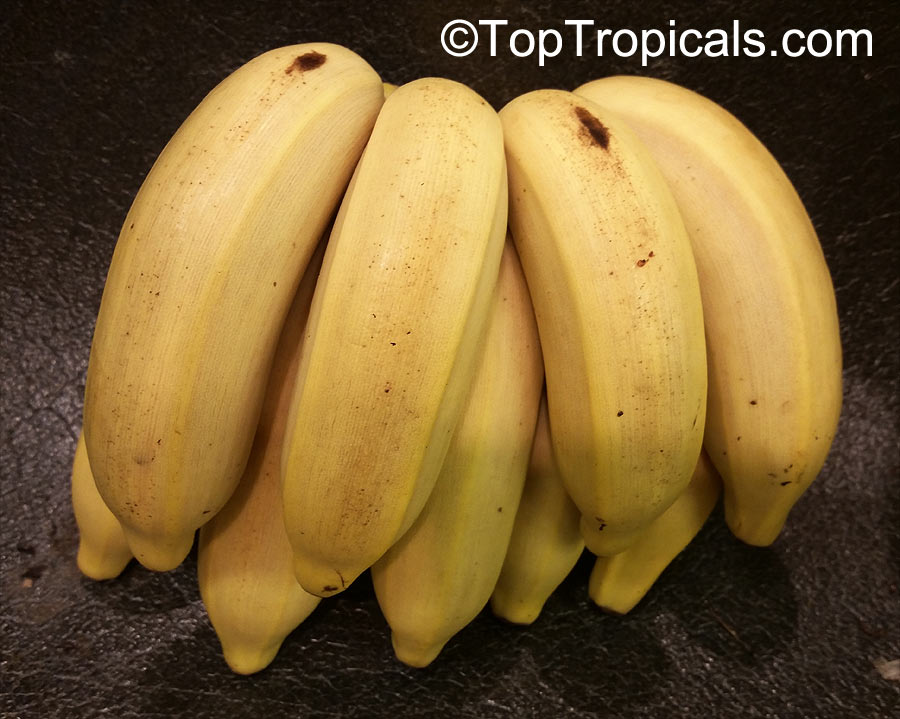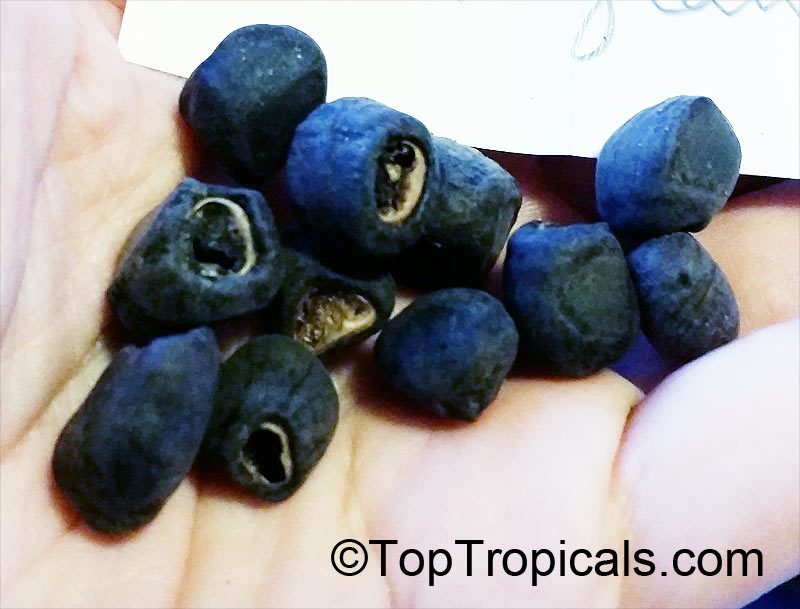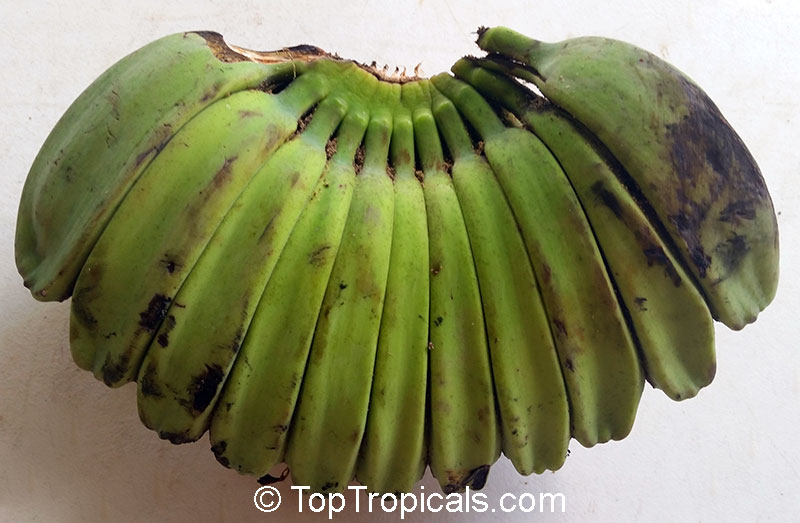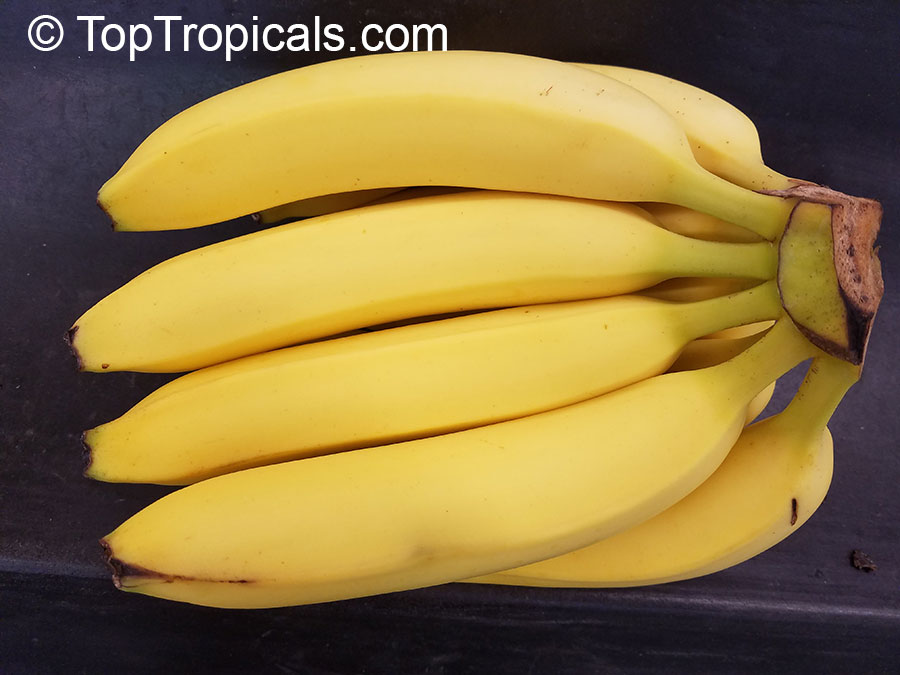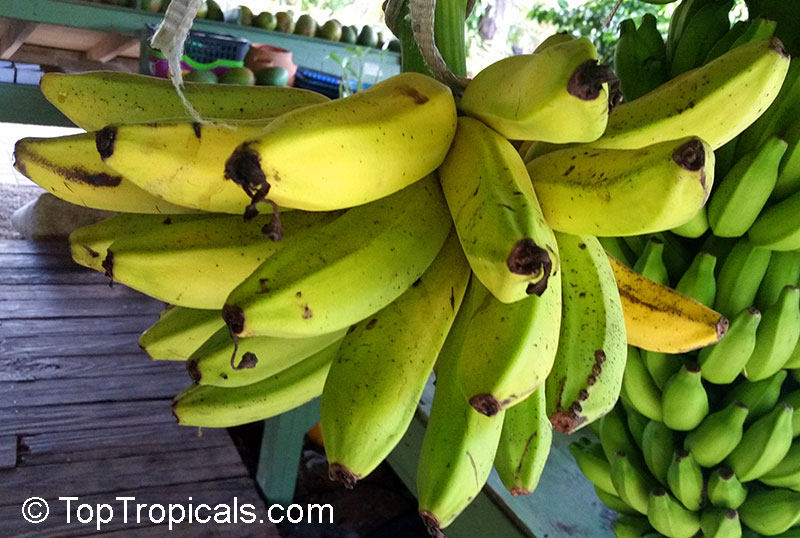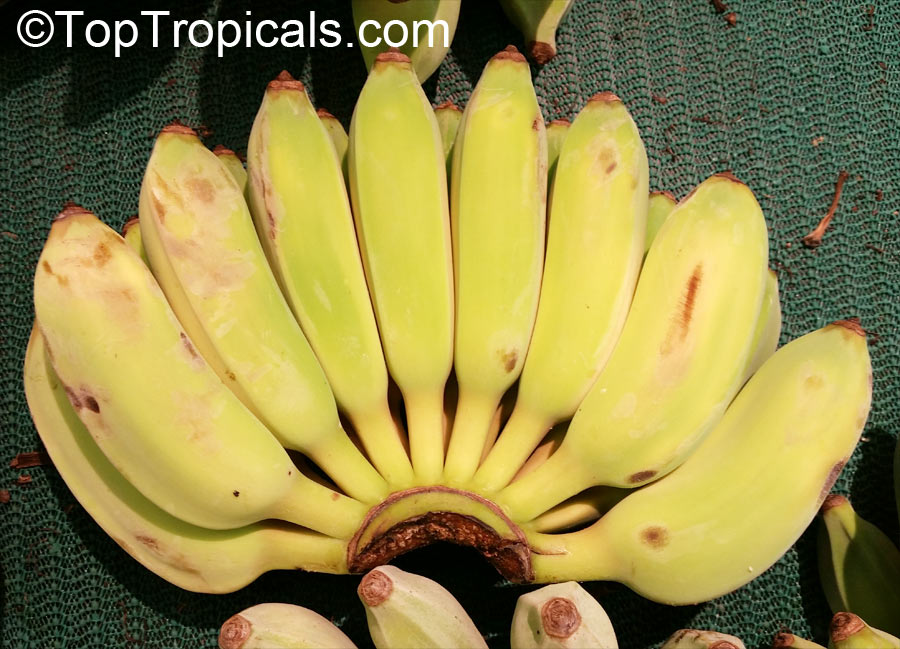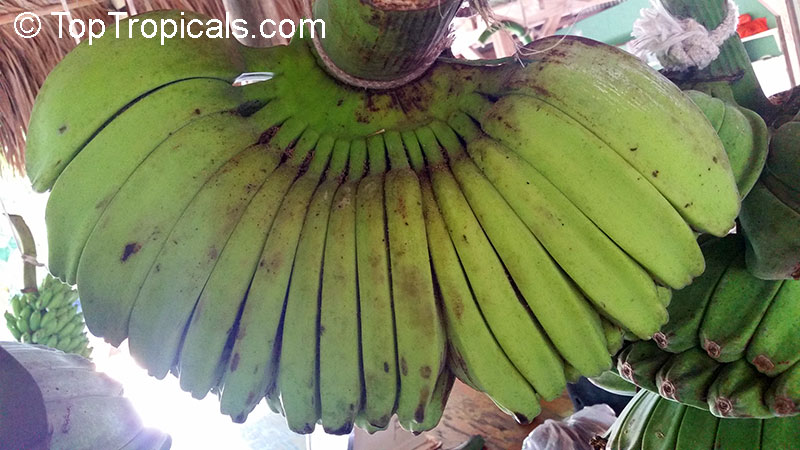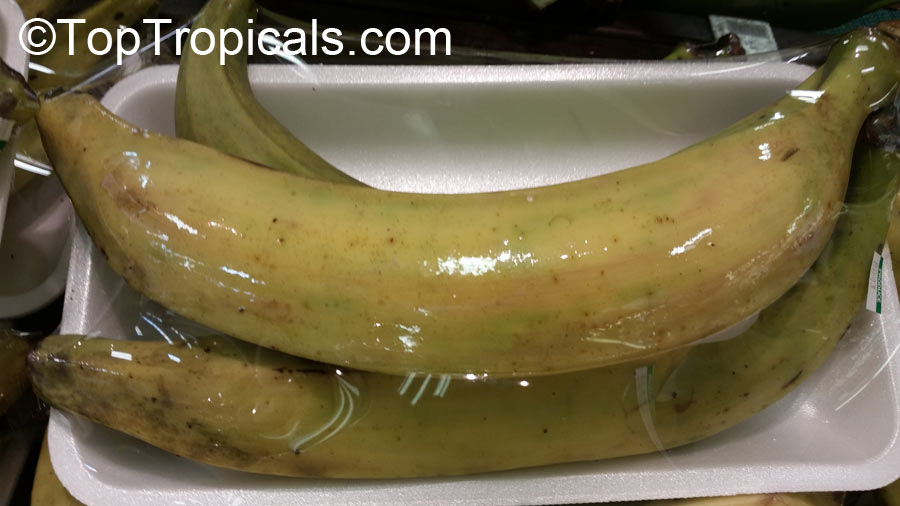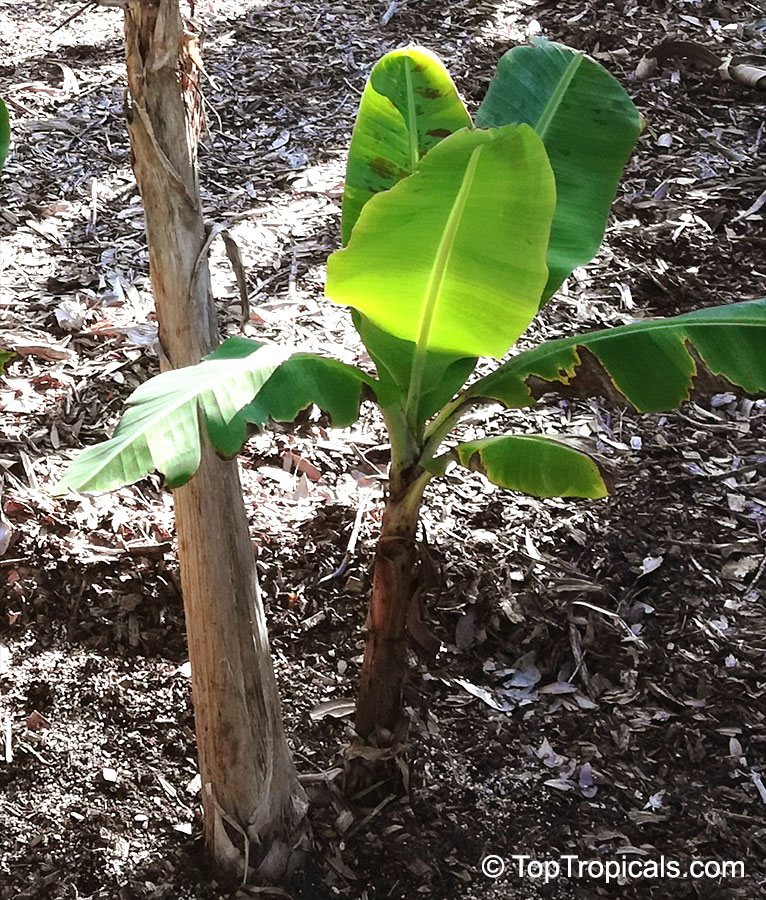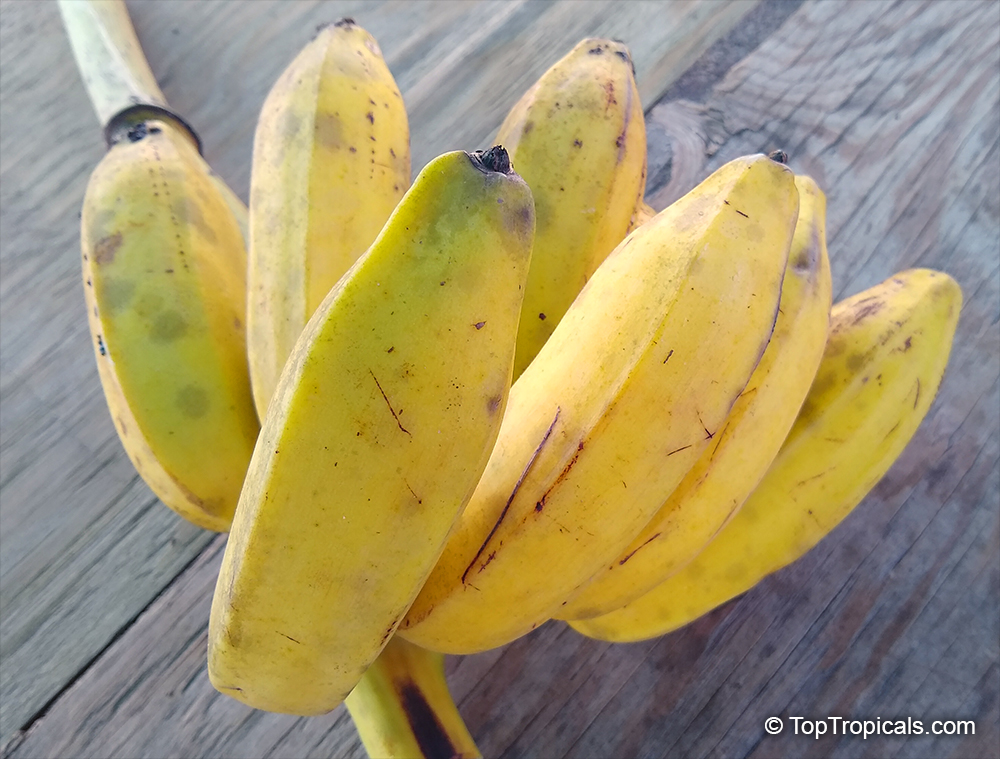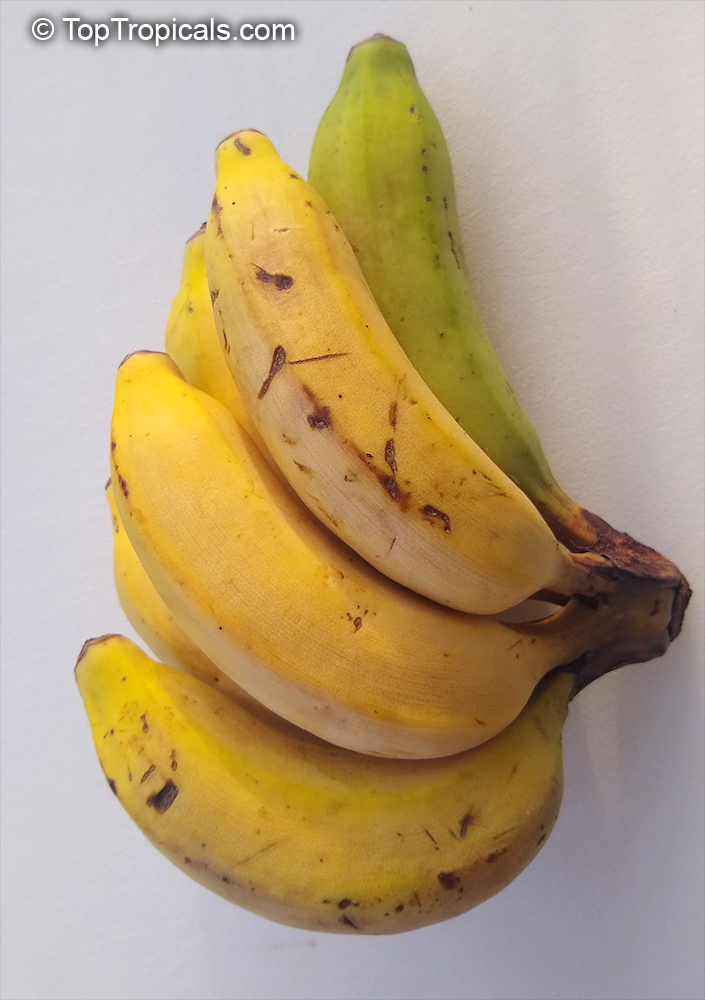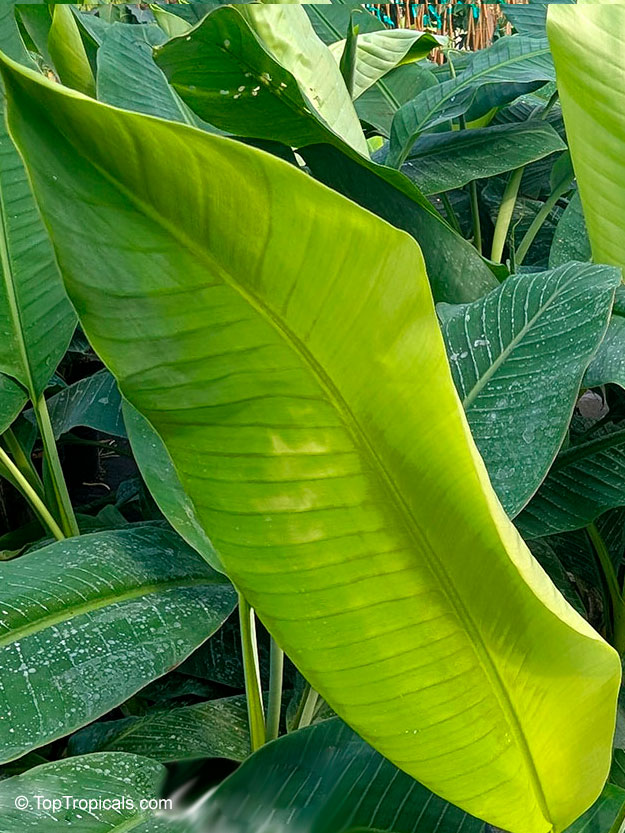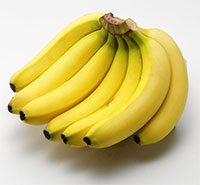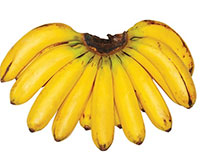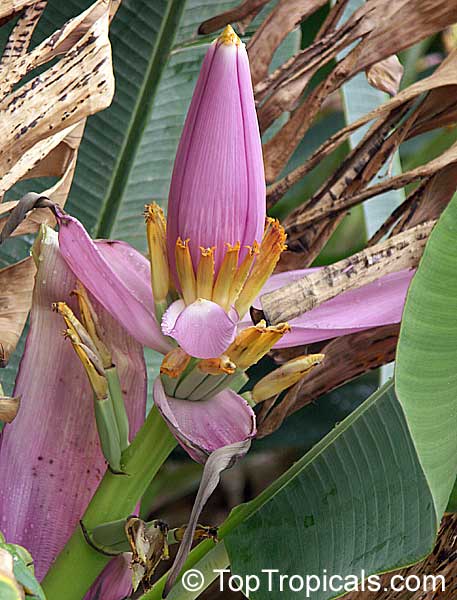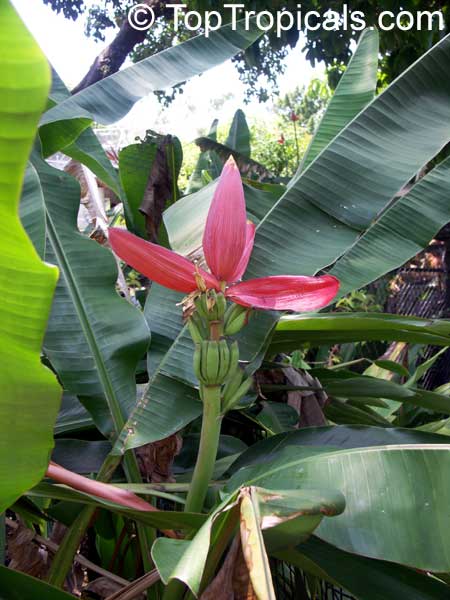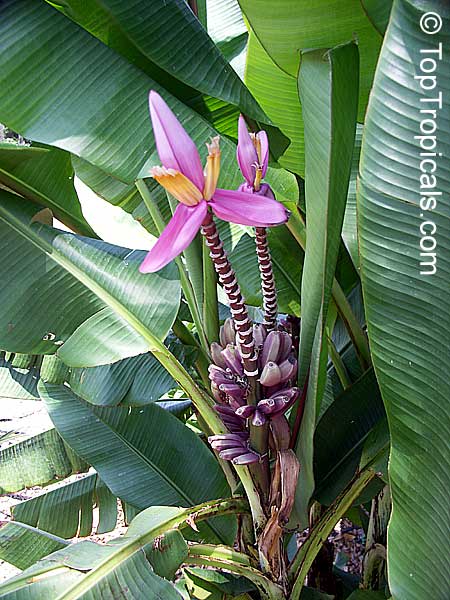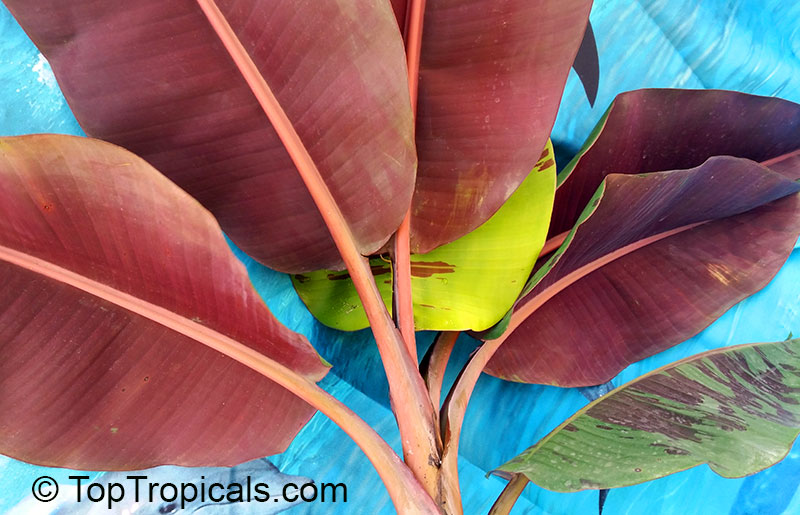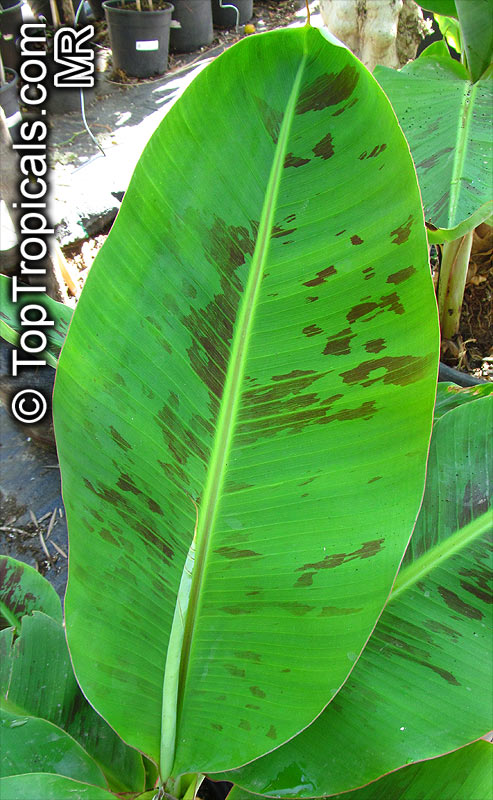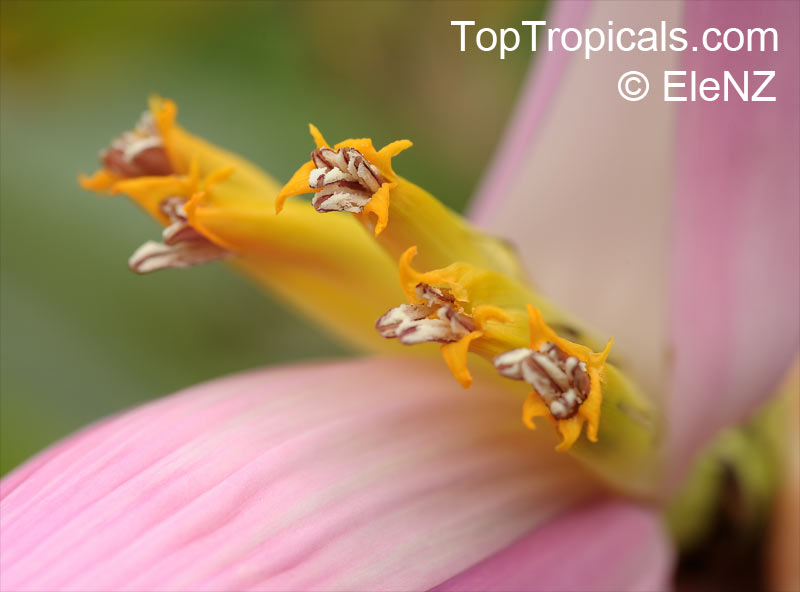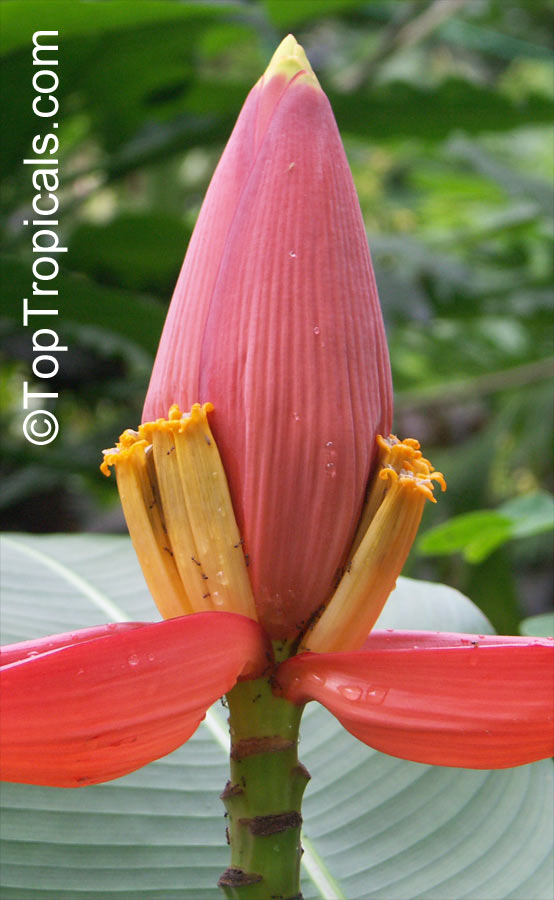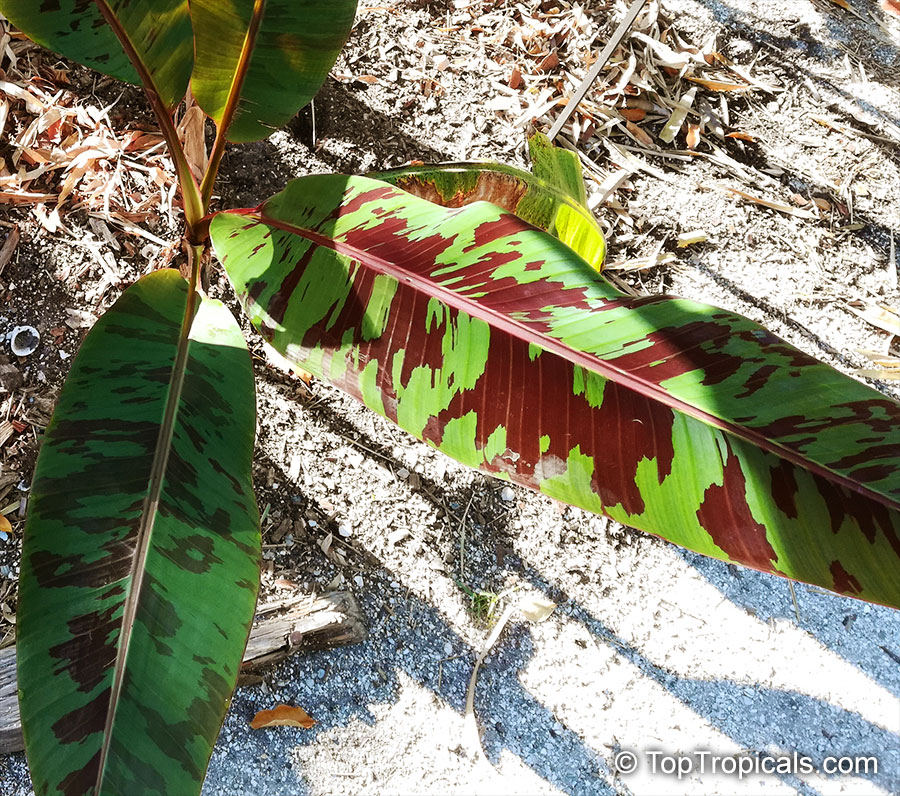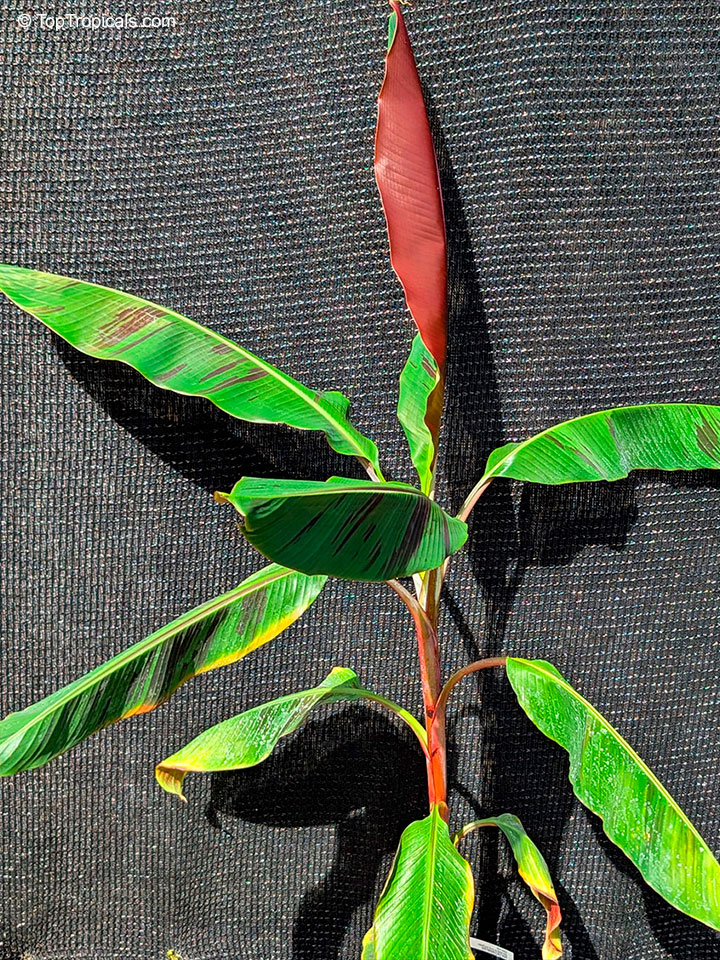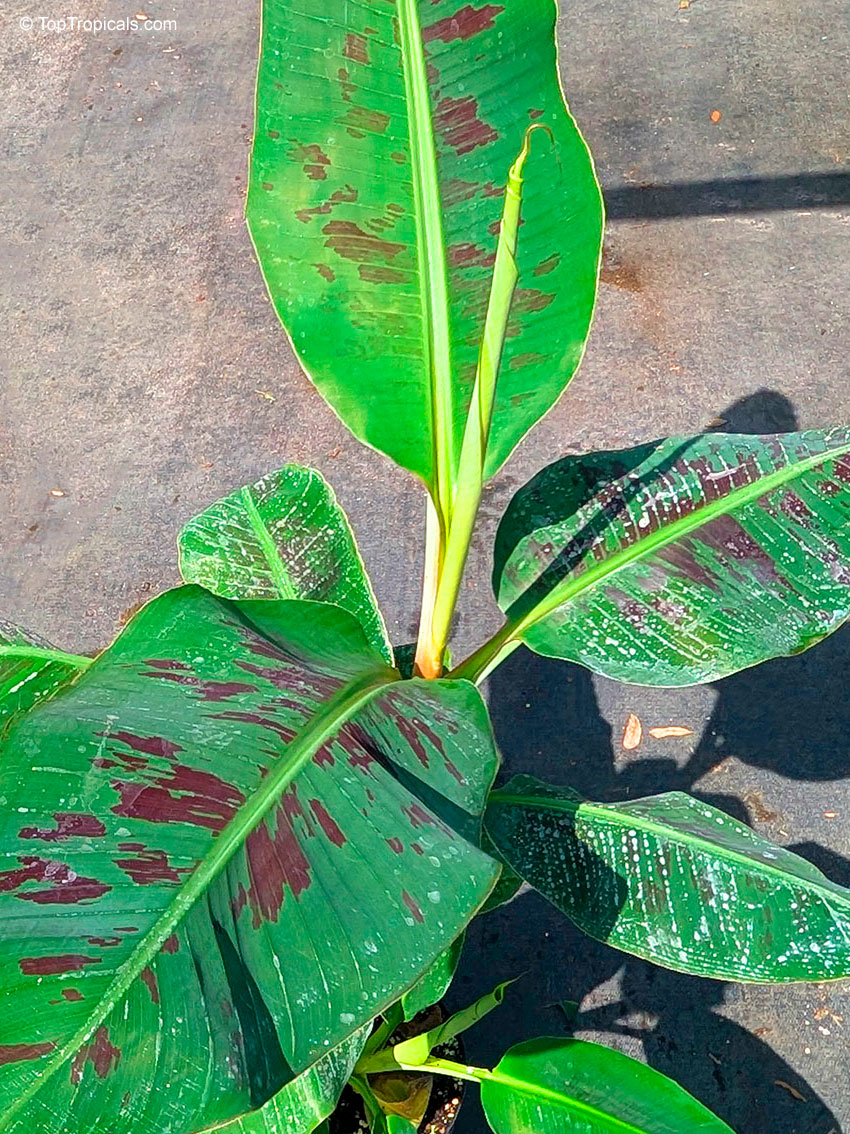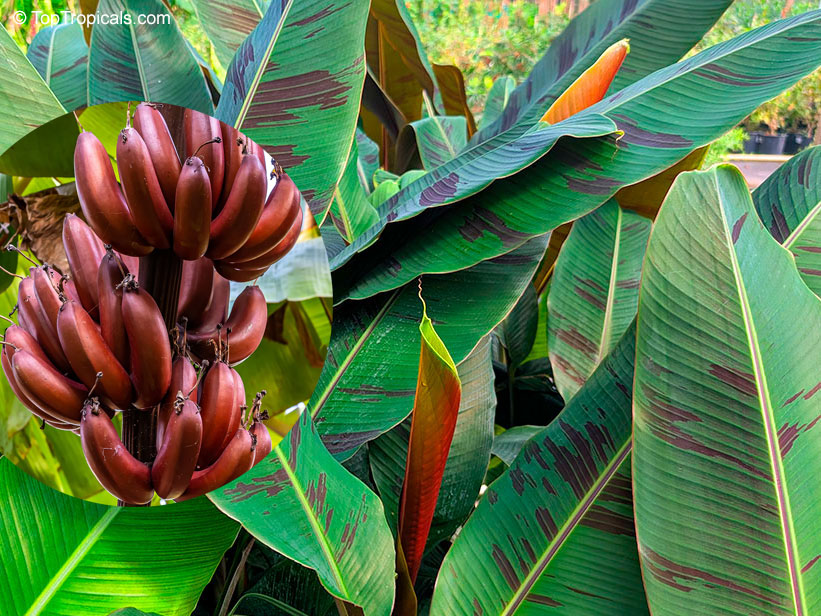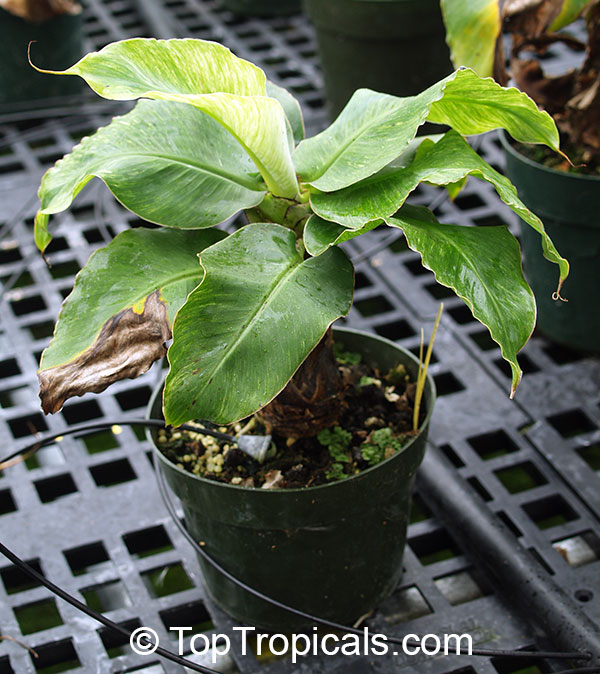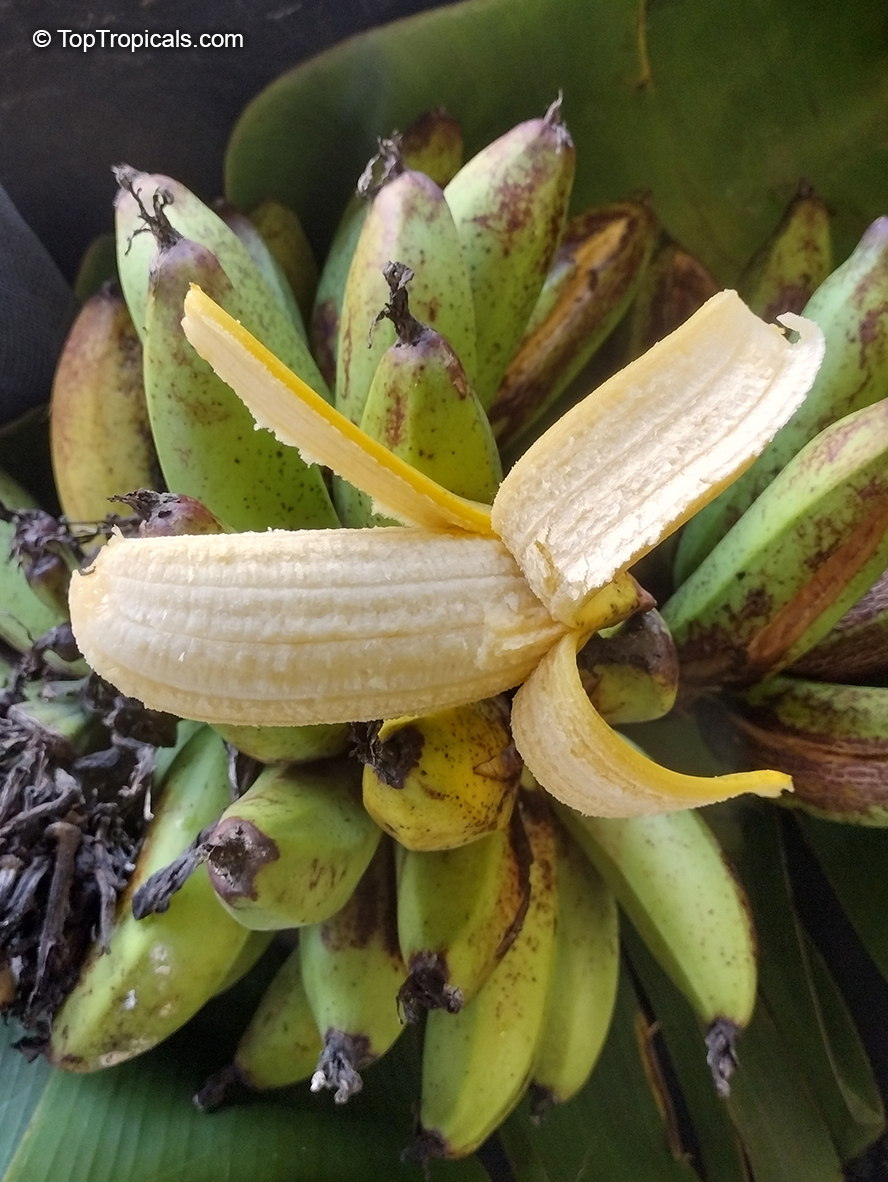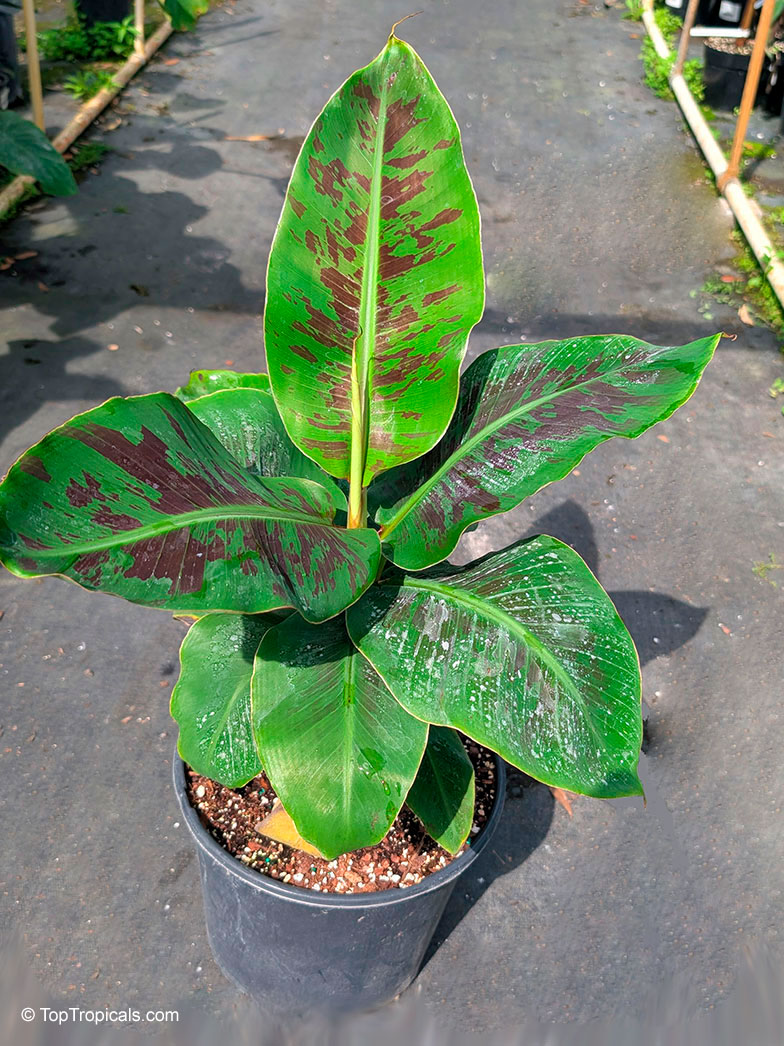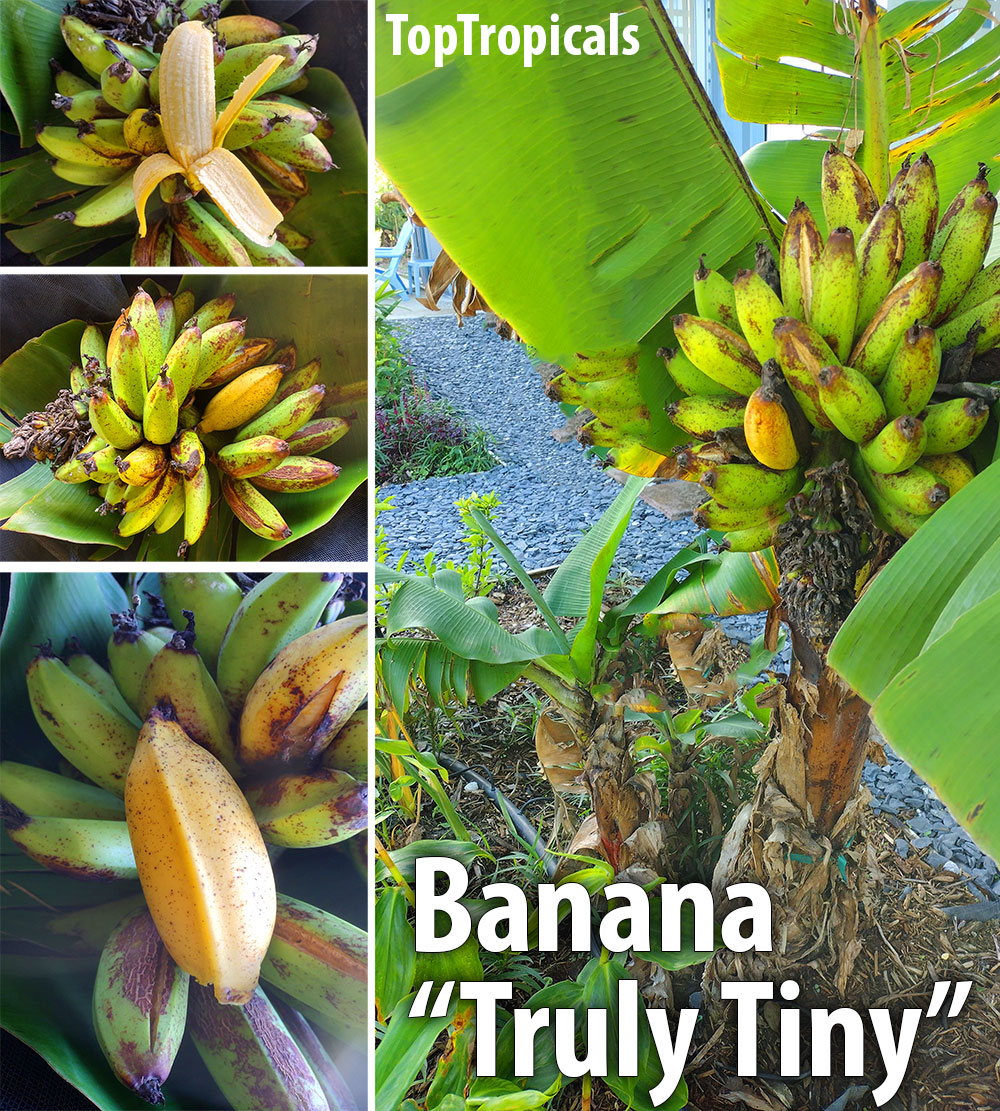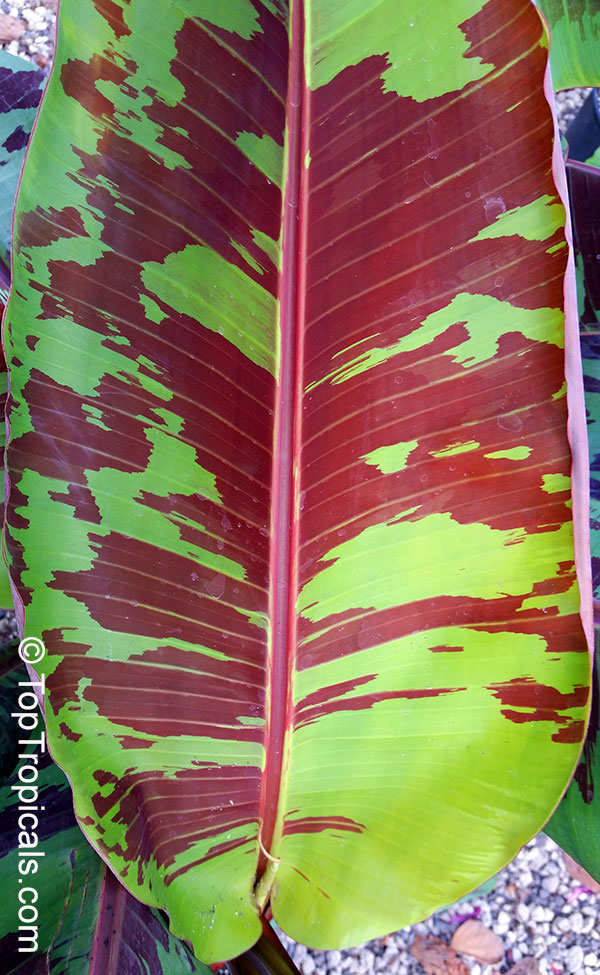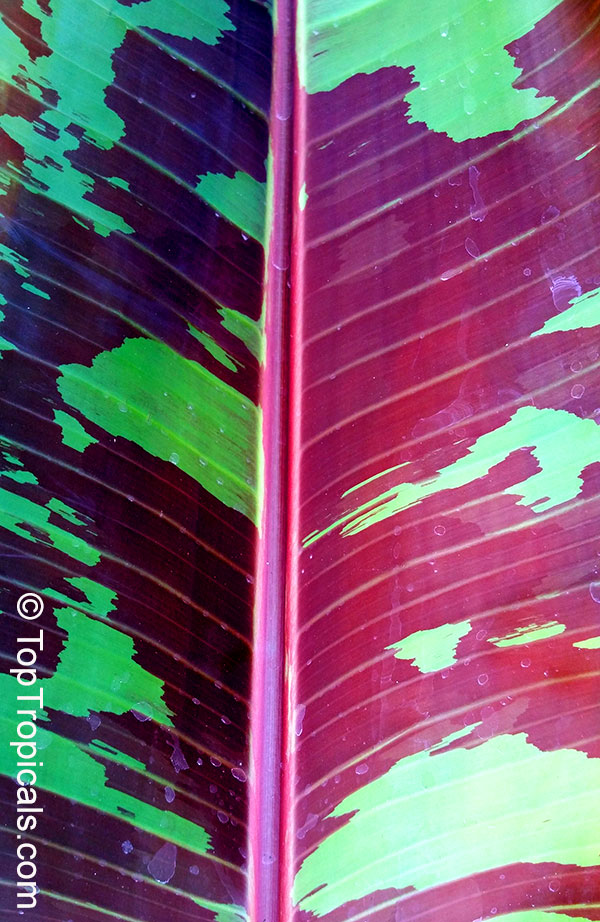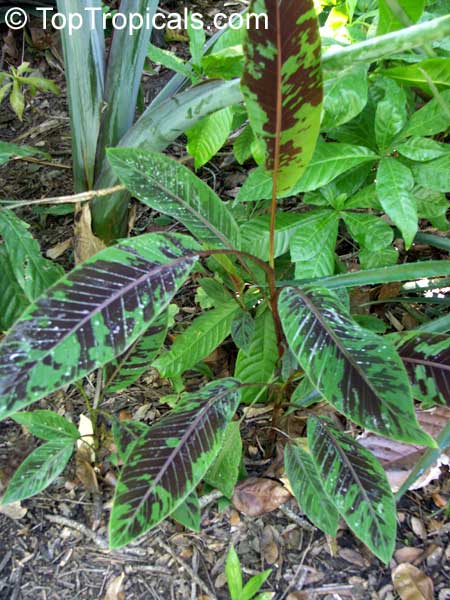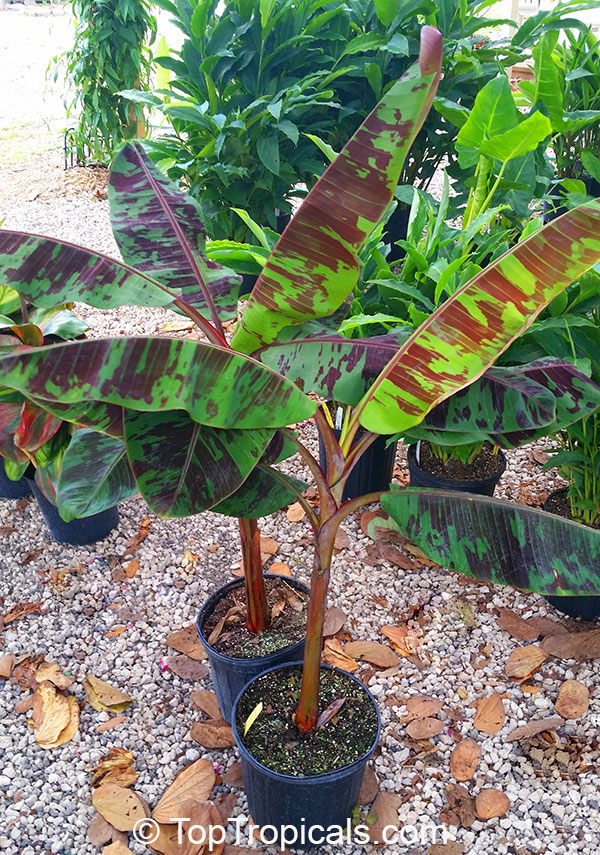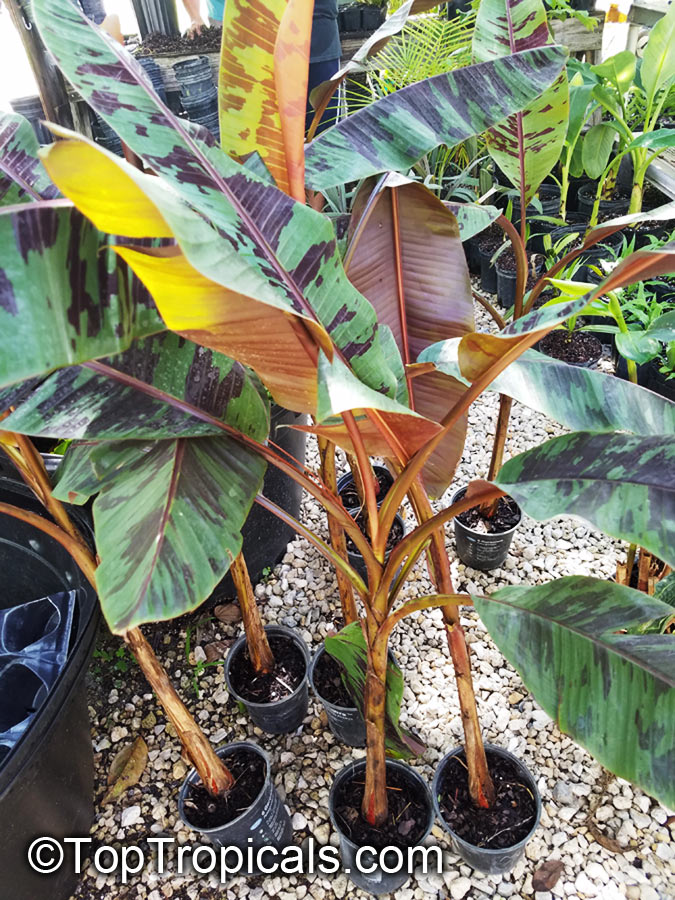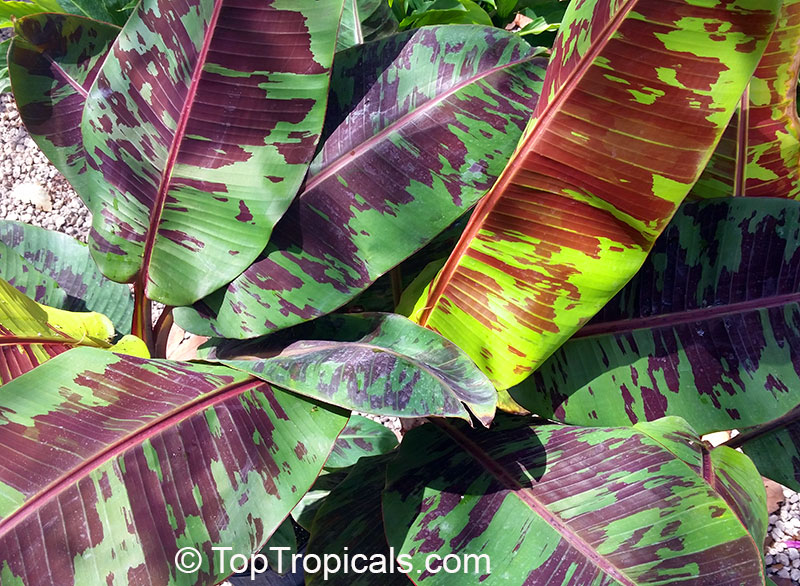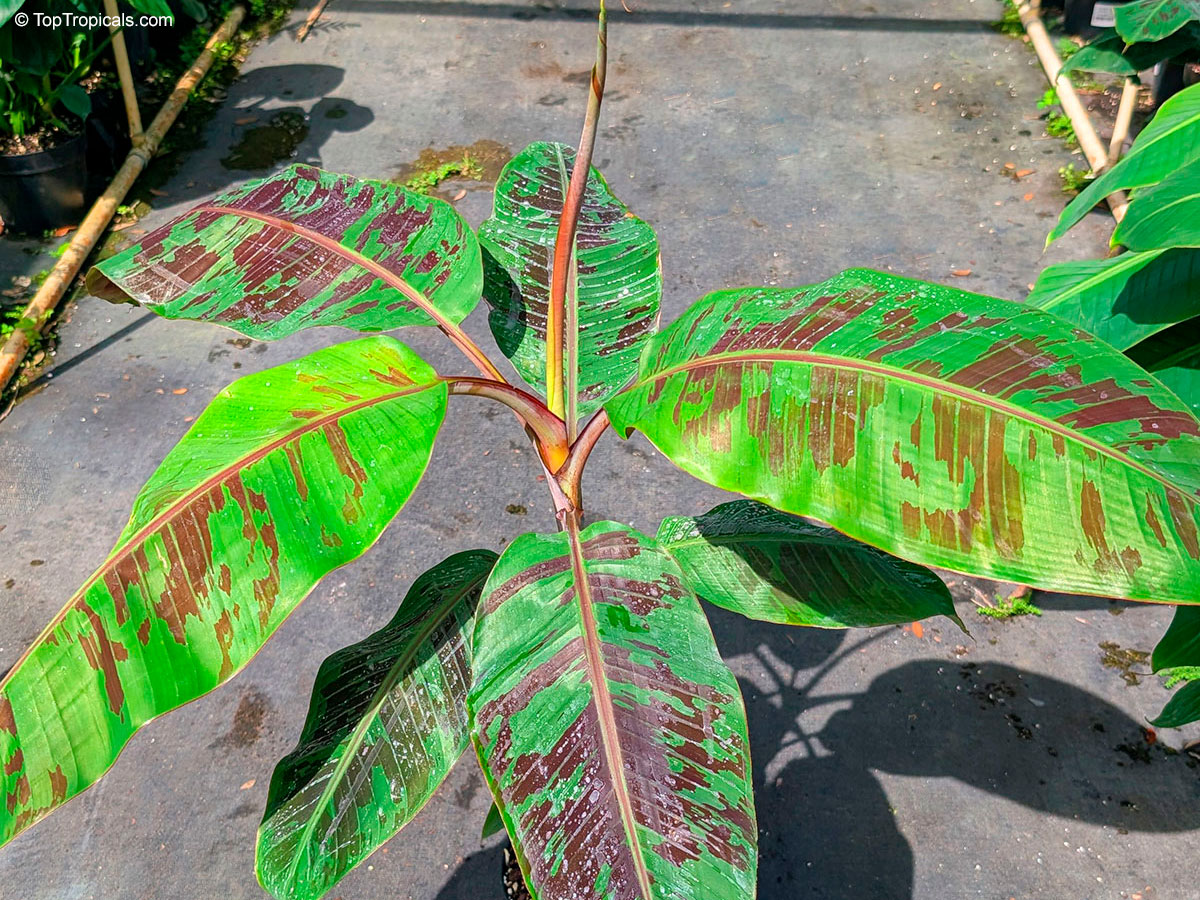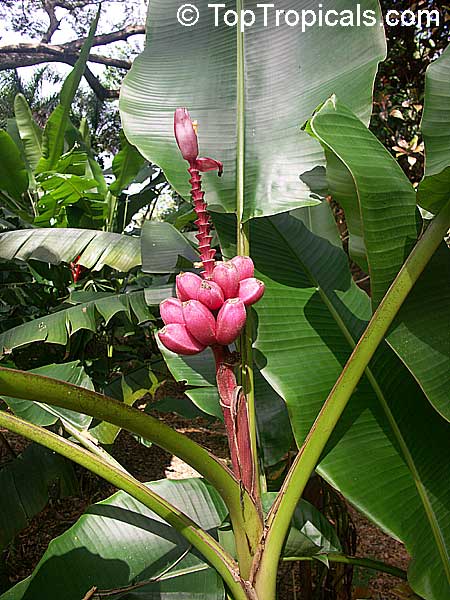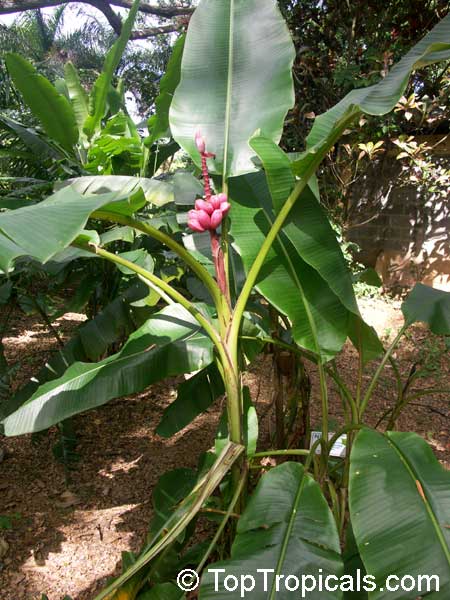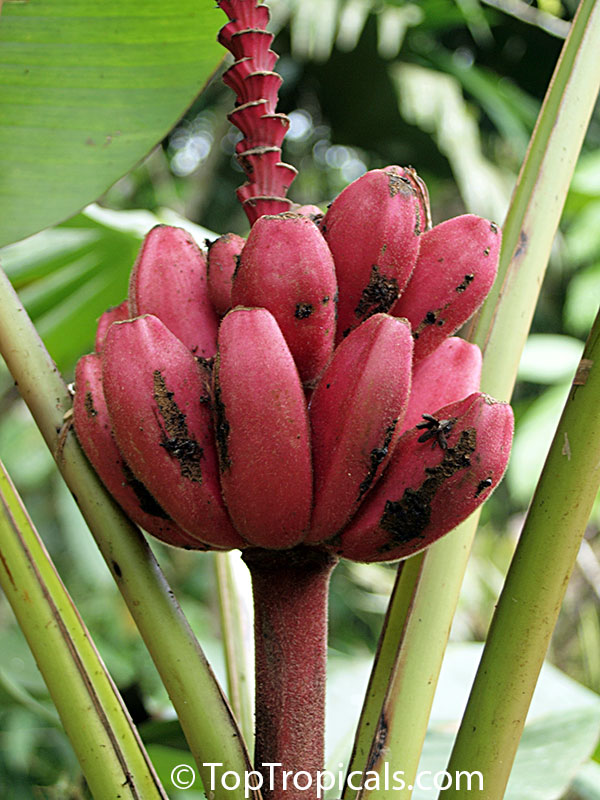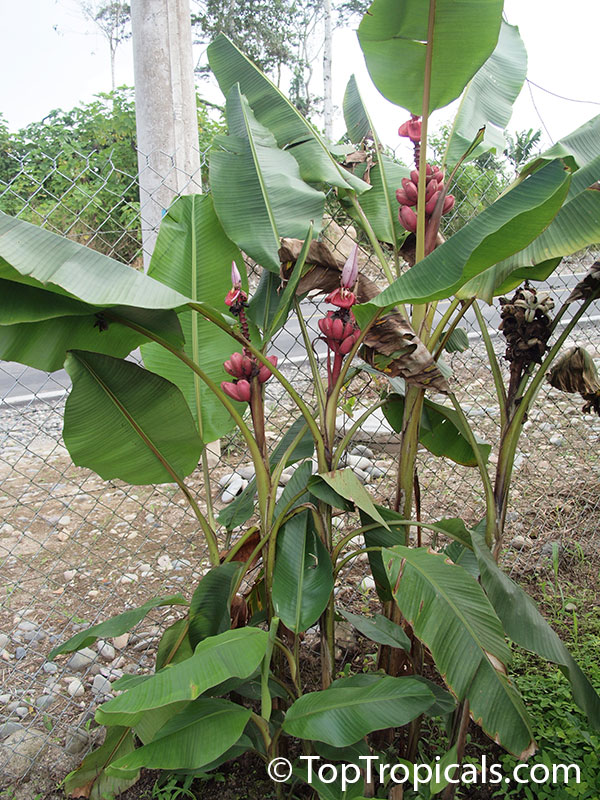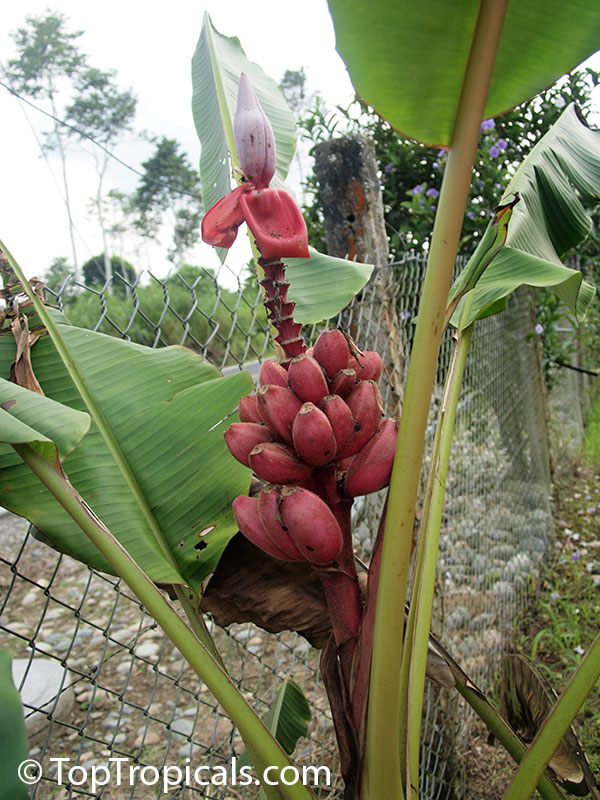Musaceae - Botanical Family
Top Tropicals Plant Encyclopedia
| Number of plants found: 11 | Next | 
|
Go to page: | 1 | 2 |
Botanical names: Ensete lasiocarpum, Musella lasiocarpa, Musa lasiocarpa
Common names: Chinese Yellow Banana, Golden Lotus Banana
Family: Musaceae
Origin: China







Because of its suckering habit, it is important to give plants plenty of spacing.
Ensete lasiocarpum is a unique and attractive addition to the home garden. It is a large, evergreen shrub that can grow up to 5 - 10 feet tall and 2-5 feet wide. Native to mountainous areas in the Yunnan Province of China, its paddle-like gray-green leaves and yellow, orange flowers make it a stunning ornament in any garden. It typically blooms throughout the summer, producing an upright inflorescence of yellow tubular flowers subtended by broad, stiff, waxy, yellow bracts. Flowering usually begins in the second year and continues annually thereafter.
Ensete lasiocarpum can be grown in full sun or semi-shade, in well-drained soil, and with regular watering. It is generally winter-hardy in USDA Zone 7-10, but may survive cold winters in Zone 6 if well-protected with a thick winter mulch over the root area. For areas outside of the recommended zones 7-10, it is best to grow this plant in containers, using a well-drained potting soil mix. In order to prevent freezing in winter, containers with Ensete lasiocarpum should be brought indoors before the first frost and placed in a warm, sunny area, with reduced soil moisture. Alternatively, they can be brought into a cool, frost-free basement corner and given occasional touches of moisture in winter to prevent the soils from totally drying out. Plants should also be given ample spacing, as they have a tendency to sucker.
In terms of care, Ensete lasiocarpum should be fertilized regularly during the growing season. Mulching the soil is a recommended practice, as this helps retain moisture and minimizes weeds. In cold regions, growth in a pot is best recommended, as this will provide a much better protection from frost, and ensure the plant survival. Pots should be placed in a sheltered area, such as a patio or porch, and mulching with straw or evergreen boughs is an effective way to insulate the soil. In addition, a covering of burlap or old blankets can be used to protect the leaves from cold winds.
Botanical name: Ensete ventricosum
Common names: Red banana, Abyssinian banana, Ethiopian banana
Cultivar: Maurelii
Family: Musaceae
Origin: Tropical Africa






This banana-like perennial has large paddle-shaped leaves, which range in color from deep claret brown to red-purple to pale green, produced from the center of the plant, with thick midribs bright red beneath. White flowers are borne in inflorescences 3 to 4 feet long. Fruits are banana-like but dry and unpalatable. Large reddish leaves. Reaches 20 feet or more.
Botanical name: Musa acuminata
Common names: Banana, Cavendish Banana
Family: Musaceae
Origin: Southern Asia
Hardiness: 30°F






Musa acuminata is one of the earliest plants to be domesticated by humans for agriculture. Many of the modern edible dessert bananas are derived from this species.
Musa acuminata is a tropical banana species known for its lush, broad green leaves and fast growth. It forms a tall, upright pseudostem that can reach 10 to 20 feet in height, creating a dramatic presence in the garden. The plant produces large, pendulous flower spikes with overlapping purple-red bracts that reveal rows of creamy-yellow flowers inside. These are followed by elongated, curved fruits bananas that are typically seedless, edible, and vary in size and sweetness depending on the cultivar. Musa acuminata thrives in full sun with rich, well-draining soil and regular watering. It prefers warm, humid conditions and should be protected from strong winds and cold. Ideal for USDA zones 9 11, it can also be grown in containers in cooler climates and overwintered indoors.
Botanical name: Musa coccinea
Common names: Scarlet Banana, Red-flowering Banana
Family: Musaceae
Origin: Tropical China and Vietnam.





Musa coccinea - Scarlet Banana, Red-flowering Banana - is a small, tropical banana with stunning red flowers that bring a vibrant, exotic touch to rare plant collection. Native to China and Vietnam, it features glossy, dark green leaves that resemble classic banana leaves. Its beauty lies in the striking red flower bracts, which surround delicate yellow tubular blooms, creating a vivid contrast. These flowers appear in summer and last about two months, making them a showstopper.
Though it doesn't produce edible bananas, the plant grows small orange fruits that add to its ornamental appeal. Each trunk (called a pseudostem) lasts until it flowers and fruits, then dies back. New shoots (banana pups) sprout from the roots, ensuring the plant continues to thrive.
Compact and easy to grow, Scarlet Banana is perfect for adding a tropical flair to small gardens or pots. Its long-lasting flowers also make excellent cut arrangements, adding a burst of color indoors.
Though it doesn't produce edible bananas, the plant grows small orange fruits that add to its ornamental appeal. Each trunk (called a pseudostem) lasts until it flowers and fruits, then dies back. New shoots (banana pups) sprout from the roots, ensuring the plant continues to thrive.
Compact and easy to grow, Scarlet Banana is perfect for adding a tropical flair to small gardens or pots. Its long-lasting flowers also make excellent cut arrangements, adding a burst of color indoors.
Recommended Fertilizer: SUNSHINE Robusta - Rapid Growth Booster
Botanical name: Musa haekkinenii
Common name: Wild Red Banana
Family: Musaceae
Origin: Vietnam





Musa haekkinenii is a small plant (1 to 1.5 m high) that has an erect inflorescence and a slender pseudostem (3-4 cm in diameter). Its leaf habit is semi-erect and it produces 2 to 6 suckers close to the base of the mother plant. Musa haekkinenii flowers continuously and has long lasting bright red bracts. Prefers full sun and good drainage.
Botanical name: Musa sp.
Common names: Banana, Bananier Nain, Canbur, Curro, Plantain
Family: Musaceae
Origin: Indo-Malaysian region reaching to Northern Australia
Hardiness: 10°F





Bananas are fast-growing herbaceous perennials arising from underground rhizomes. The fleshy stalks or pseudostems formed by upright concentric layers of leaf sheaths constitute the functional trunks. The true stem begins as an underground corm which grows upwards, pushing its way out through the center of the stalk 10-15 months after planting, eventually producing the terminal inflorescence which will later bear the fruit. Each stalk produces one huge flower cluster and then dies. New stalks then grow from the rhizome. Banana plants are extremely decorative, ranking next to palm trees for the tropical feeling they lend to the landscape. The banana inflorescence shooting out from the heart in the tip of the stem, is at first a large, long-oval, tapering, purple-clad bud. As it opens, the slim, nectar-rich, tubular, toothed, white flowers appear. They are clustered in whorled double rows along the the floral stalk, each cluster covered by a thick, waxy, hood like bract, purple outside and deep red within. The flowers occupying the first 5 - 15 rows are female. As the rachis of the inflorescence continues to elongate, sterile flowers with abortive male and female parts appear, followed by normal staminate ones with abortive ovaries. The two latter flower types eventually drop in most edible bananas. The ovaries contained in the first (female) flowers grow rapidly, developing parthenocarpically (without pollination) into clusters of fruits, called hands. The number of hands varies with the species and variety. The fruit (technically a berry) turns from deep green to yellow or red, and may range from 2-1/2 to 12 inches in length and 3/4 to 2 inches in width. The flesh, ivory-white to yellow or salmon-yellow, may be firm, astringent, even gummy with latex when unripe, turning tender and slippery, or soft and mellow or rather dry and mealy or starchy when ripe. The flavor may be mild and sweet or subacid with a distinct apple tone. The common cultivated types are generally seedless with just vestiges of ovules visible as brown specks. Occasionally, cross-pollination with wild types will result in a number of seeds in a normally seedless variety. Bananas require as much warmth as can be given them. Additional warmth can be given by planting next to a building. Planting next to cement or asphalt walks or driveways also helps. Wind protection is advisable, not for leaf protection as much as for protection of the plant after the banana stalk has appeared. During these last few months propping should be done to keep the plant from tipping or being blown over.
Musa Praying Hands - produces perhaps the most unusual and distinctive of all banana fruits. Two adjacent hands of bananas are fused, giving the appearance of praying hands. This is not just a collectors item, the fruits are delicious ripe, containing a hint of vanilla flavor. When totally ripe, individual bananas can be carefully separated from each other. An excellent all-around plant with some wind resistance; it is very collectible.
All eating bananas are triploid varieties of M. acuminata x bulbisiana.
There are numerous cultivars of Cooking banana.
Recommended Fertilizer: SUNSHINE Robusta - Rapid Growth Booster
Recommended Fertilizer: SUNSHINE Robusta - Rapid Growth Booster
Recommended Fertilizer: SUNSHINE Robusta - Rapid Growth Booster
Recommended Fertilizer: SUNSHINE Robusta - Rapid Growth Booster
Recommended Fertilizer: SUNSHINE Robusta - Rapid Growth Booster
Recommended Fertilizer: SUNSHINE Robusta - Rapid Growth Booster
Recommended Fertilizer: SUNSHINE Robusta - Rapid Growth Booster
Botanical name: Musa sp.
Common name: Ornamental bananas
Cultivar group: Ornamental Group
Family: Musaceae
Hardiness: 30°F






Musa ornamental refers to a group of banana plants grown primarily for their striking foliage, colorful stems, and unusual flowers rather than for edible fruit. These ornamental bananas often feature bold, tropical-looking leaves that may be green, red, purple, or variegated, depending on the variety. Some cultivars, like Musa ornata or Musa velutina, produce vibrant inflorescences in shades of pink, orange, or yellow, which are followed by small, upright fruits that are typically full of seeds and not intended for consumption. Ornamental bananas add a lush, exotic feel to gardens and landscapes, thriving in full sun to partial shade with rich, moist, and well-draining soil. They require regular watering during the growing season and protection from cold. Best suited for USDA zones 9 11, they can also be grown in large pots and brought indoors in cooler climates to enjoy their tropical appeal year-round.
Recommended Fertilizer: SUNSHINE Robusta - Rapid Growth Booster
This item can not be shipped. Pick up only. We can provide local delivery around Ft. Myers or Sebring, Florida. Contact us for an estimate. Non-pickup orders are subject to restocking fees.
Recommended Fertilizer: SUNSHINE Robusta - Rapid Growth Booster
This item can not be shipped. Pick up only. We can provide local delivery around Ft. Myers or Sebring, Florida. Contact us for an estimate. Non-pickup orders are subject to restocking fees.
Recommended Fertilizer: SUNSHINE Robusta - Rapid Growth Booster
Botanical name: Musa sp.
Common name: Dwarf Banana 'Truly Tiny'
Cultivar: Truly Tiny
Family: Musaceae
Origin: Brazil
Hardiness: 30°F






Dwarf Banana 'Truly Tiny' is a miniature banana cultivar, presumably derived from a dwarf banana variety native to Brazil. 'Truly Tiny' is one of the smallest edible banana varieties. his compact banana variety growing 2-3 feet in pots and up to 5 feet in the ground, perfect for small spaces or container gardening, producing 4-5 inch fruit with a distinctive pineapple flavor. It features lush green leaves often marked with burgundy or reddish-purple spots, especially in young plants, making it highly ornamental. The plant can produce small, sweet, edible bananas under warm conditions. T It thrives in full sun to partial shade, with well-draining soil and regular watering. Suitable for USDA zones 9-11 or indoor growing in cooler climates.
The fruit are 4-5" long, nice and full, and have very distinctive pineapple flavor.
Recommended Fertilizer: SUNSHINE Robusta - Rapid Growth Booster
Botanical names: Musa sumatrana, Musa acuminata subsp. zebrina
Common name: Blood Leaf Banana
Family: Musaceae
Origin: Southeast Asia
Hardiness: 20°F







The Blood Leaf Banana is a subspecies of the wild banana species Musa acuminata, one of the two ancestors of modern edible bananas. This plant is grown for its attractive foliage. The fruit is seeded. The stem is completely red. The leaves are narrow with green and red mottling on the top and solid maroon coloring on the bottom.
The leaves are paddle-shaped and have green and red mottling on top, with a solid maroon color on the bottom. When grown in a container, the plant can be kept to a height of 4-6 ft, but can grow to be 5-8 ft tall when planted in the ground. The plant can be used as a focal point or in mass plantings in a garden, or grown in a container. It can also provide a backdrop for other smaller tropical plants.
See photos of leaves:
Picture 1
Picture 2
Picture 3
See Article about Red leaf Banana.
Recommended Fertilizer: SUNSHINE Robusta - Rapid Growth Booster
Botanical name: Musa velutina
Common names: Hairy Banana, Pink Banana
Family: Musaceae
Origin: India






It is a large shrub, reaching up to five and ten feet tall, that typically thrives in tropical climates. Its bright pink flowers, which bloom during the summer months, make it a highly sought-after ornamental plant.
Musa velutina is a plant native to India. This large shrub will grow anywhere from five to ten feet tall and enjoys full sun or semi-shade with regular water. Additionally, it requires a temperature of at least 55 degrees Fahrenheit, meaning it is hardy in USDA Zones 8-11.
Musa velutina is grown for both its beauty and its edible fruit. The plant's clusters of bright pink flowers add a splash of color to a garden, and its fruit, which matures in autumn, are edible and sweet. The fruits are small, oval-shaped, and generally weigh less than half a pound. They can be eaten raw or cooked, and can also be used to make jam and other types of preserves.
This plant is not only edible, but also contains a number of healthy benefits. The fruits are a good source of dietary fiber, vitamins and minerals, and are low in fats and calories. Additionally, they provide a substantial amount of vitamin C and essential nutrients, such as potassium, magnesium and iron.
In terms of producing fruit, Musa velutina is quite prolific. One plant can produce up to fifty fruits in a single growing season with proper care. To ensure that this plant produces a good crop of fruit, they should be planted in well-draining soil and fertilized once every two weeks. In regions with colder climates, this plant can also be grown in a pot, as long as it is kept in a location where it can receive enough sunlight to flower and fruit.
| Next |  |
Use link to repeat this search:
https://toptropicals.com/cgi-bin/garden_catalog/cat.cgi?search_op=and&keyword_op=and&language=e&family=Musaceae&number=10
&no_change_lang=1&user=tt&sale=1&first=0
